Doing Business in China - PDF
VerifiedAdded on 2021/05/31
|34
|9156
|31
AI Summary
Contribute Materials
Your contribution can guide someone’s learning journey. Share your
documents today.
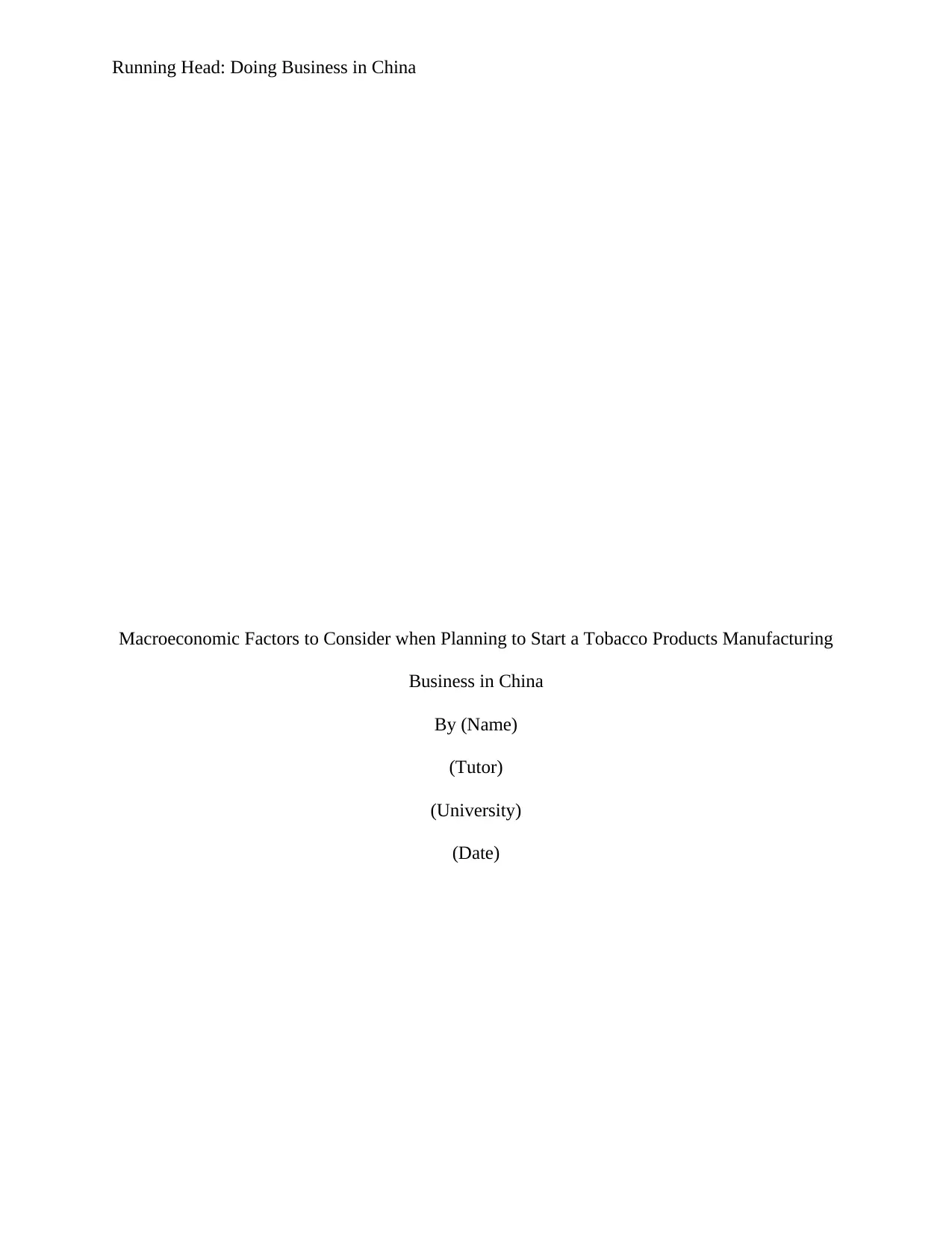
Running Head: Doing Business in China
Macroeconomic Factors to Consider when Planning to Start a Tobacco Products Manufacturing
Business in China
By (Name)
(Tutor)
(University)
(Date)
Macroeconomic Factors to Consider when Planning to Start a Tobacco Products Manufacturing
Business in China
By (Name)
(Tutor)
(University)
(Date)
Secure Best Marks with AI Grader
Need help grading? Try our AI Grader for instant feedback on your assignments.
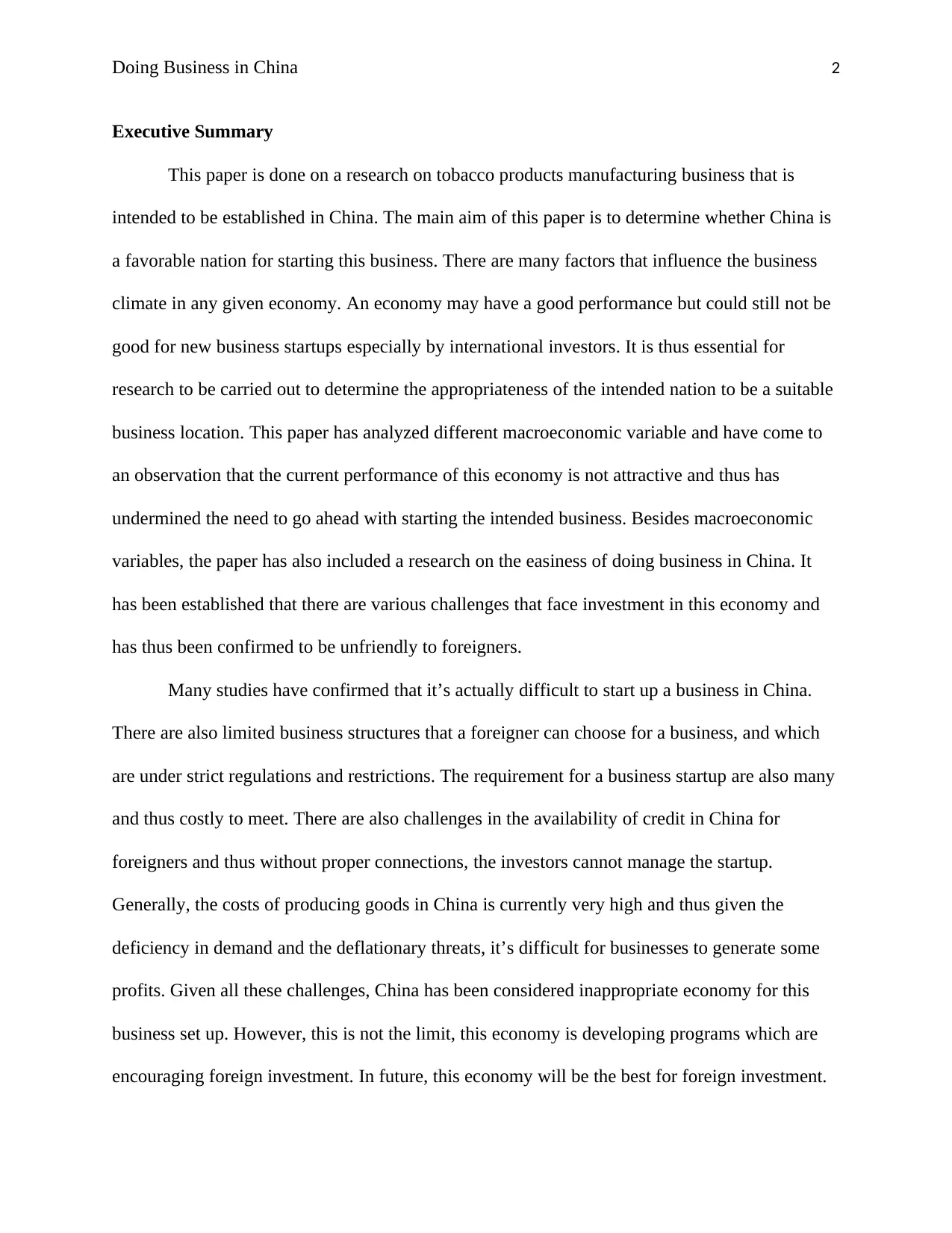
Doing Business in China 2
Executive Summary
This paper is done on a research on tobacco products manufacturing business that is
intended to be established in China. The main aim of this paper is to determine whether China is
a favorable nation for starting this business. There are many factors that influence the business
climate in any given economy. An economy may have a good performance but could still not be
good for new business startups especially by international investors. It is thus essential for
research to be carried out to determine the appropriateness of the intended nation to be a suitable
business location. This paper has analyzed different macroeconomic variable and have come to
an observation that the current performance of this economy is not attractive and thus has
undermined the need to go ahead with starting the intended business. Besides macroeconomic
variables, the paper has also included a research on the easiness of doing business in China. It
has been established that there are various challenges that face investment in this economy and
has thus been confirmed to be unfriendly to foreigners.
Many studies have confirmed that it’s actually difficult to start up a business in China.
There are also limited business structures that a foreigner can choose for a business, and which
are under strict regulations and restrictions. The requirement for a business startup are also many
and thus costly to meet. There are also challenges in the availability of credit in China for
foreigners and thus without proper connections, the investors cannot manage the startup.
Generally, the costs of producing goods in China is currently very high and thus given the
deficiency in demand and the deflationary threats, it’s difficult for businesses to generate some
profits. Given all these challenges, China has been considered inappropriate economy for this
business set up. However, this is not the limit, this economy is developing programs which are
encouraging foreign investment. In future, this economy will be the best for foreign investment.
Executive Summary
This paper is done on a research on tobacco products manufacturing business that is
intended to be established in China. The main aim of this paper is to determine whether China is
a favorable nation for starting this business. There are many factors that influence the business
climate in any given economy. An economy may have a good performance but could still not be
good for new business startups especially by international investors. It is thus essential for
research to be carried out to determine the appropriateness of the intended nation to be a suitable
business location. This paper has analyzed different macroeconomic variable and have come to
an observation that the current performance of this economy is not attractive and thus has
undermined the need to go ahead with starting the intended business. Besides macroeconomic
variables, the paper has also included a research on the easiness of doing business in China. It
has been established that there are various challenges that face investment in this economy and
has thus been confirmed to be unfriendly to foreigners.
Many studies have confirmed that it’s actually difficult to start up a business in China.
There are also limited business structures that a foreigner can choose for a business, and which
are under strict regulations and restrictions. The requirement for a business startup are also many
and thus costly to meet. There are also challenges in the availability of credit in China for
foreigners and thus without proper connections, the investors cannot manage the startup.
Generally, the costs of producing goods in China is currently very high and thus given the
deficiency in demand and the deflationary threats, it’s difficult for businesses to generate some
profits. Given all these challenges, China has been considered inappropriate economy for this
business set up. However, this is not the limit, this economy is developing programs which are
encouraging foreign investment. In future, this economy will be the best for foreign investment.

Doing Business in China 3
Table of Contents
Executive Summary........................................................................................................................2
Introduction....................................................................................................................................4
Analyses and Discussions................................................................................................................6
General Business Environment in China.....................................................................................6
The Economic Growth of China................................................................................................10
China Unemployment Rate.......................................................................................................11
Wage Rate in China...................................................................................................................12
Human Capital in China............................................................................................................13
Inflation Rate in China..............................................................................................................14
Interest Rate in China...............................................................................................................16
Domestic Credit to Private Sector.............................................................................................18
Taxation Policy in China............................................................................................................20
Exchange Rate Regime and Exchange Rate Fluctuation in China..............................................22
Slowing Retail Sales..................................................................................................................23
Two Monetary Policies in China................................................................................................24
Effects of Global Financial Crisis on China.................................................................................25
Conclusion and Recommendations..............................................................................................27
Bibliography..................................................................................................................................30
Table of Contents
Executive Summary........................................................................................................................2
Introduction....................................................................................................................................4
Analyses and Discussions................................................................................................................6
General Business Environment in China.....................................................................................6
The Economic Growth of China................................................................................................10
China Unemployment Rate.......................................................................................................11
Wage Rate in China...................................................................................................................12
Human Capital in China............................................................................................................13
Inflation Rate in China..............................................................................................................14
Interest Rate in China...............................................................................................................16
Domestic Credit to Private Sector.............................................................................................18
Taxation Policy in China............................................................................................................20
Exchange Rate Regime and Exchange Rate Fluctuation in China..............................................22
Slowing Retail Sales..................................................................................................................23
Two Monetary Policies in China................................................................................................24
Effects of Global Financial Crisis on China.................................................................................25
Conclusion and Recommendations..............................................................................................27
Bibliography..................................................................................................................................30
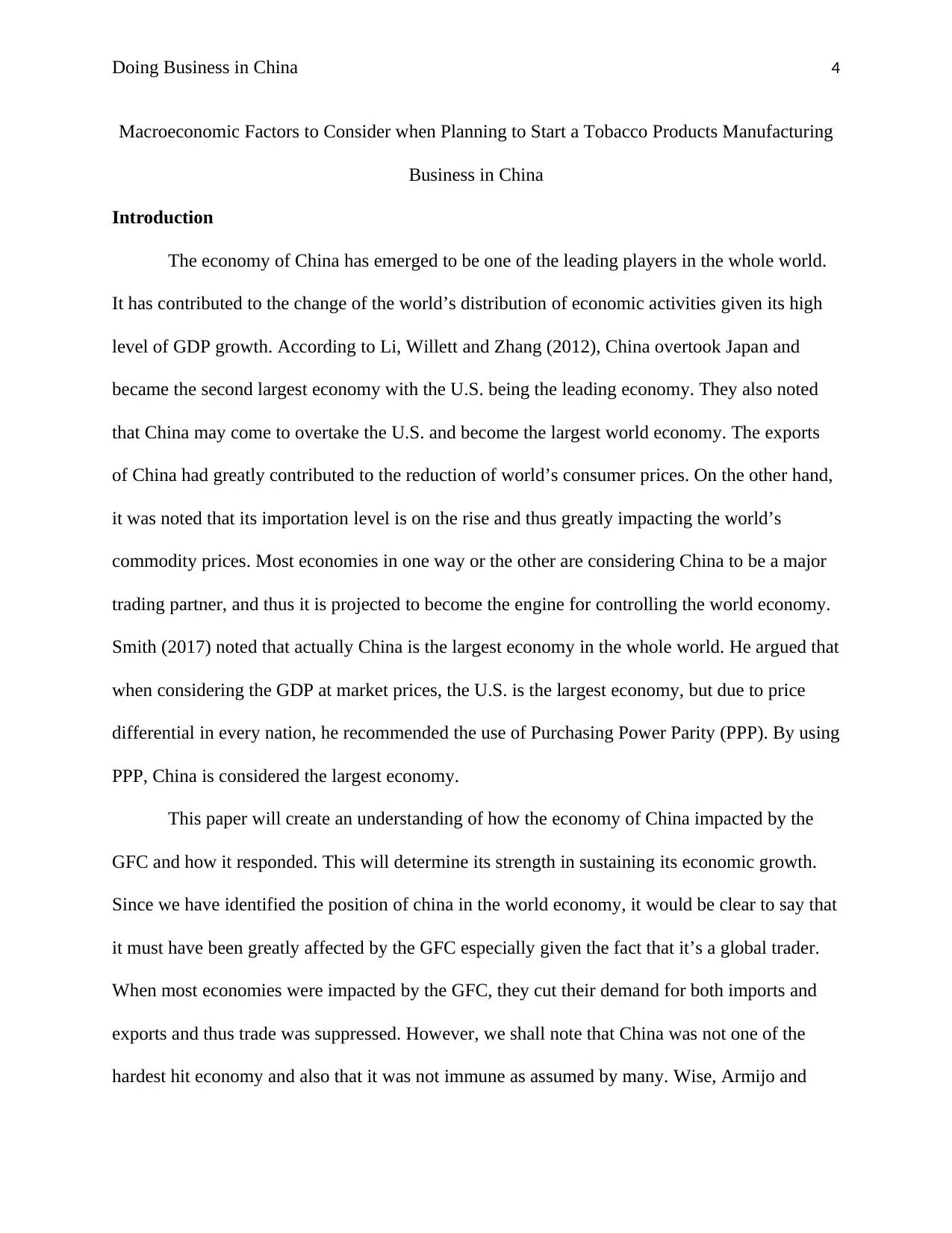
Doing Business in China 4
Macroeconomic Factors to Consider when Planning to Start a Tobacco Products Manufacturing
Business in China
Introduction
The economy of China has emerged to be one of the leading players in the whole world.
It has contributed to the change of the world’s distribution of economic activities given its high
level of GDP growth. According to Li, Willett and Zhang (2012), China overtook Japan and
became the second largest economy with the U.S. being the leading economy. They also noted
that China may come to overtake the U.S. and become the largest world economy. The exports
of China had greatly contributed to the reduction of world’s consumer prices. On the other hand,
it was noted that its importation level is on the rise and thus greatly impacting the world’s
commodity prices. Most economies in one way or the other are considering China to be a major
trading partner, and thus it is projected to become the engine for controlling the world economy.
Smith (2017) noted that actually China is the largest economy in the whole world. He argued that
when considering the GDP at market prices, the U.S. is the largest economy, but due to price
differential in every nation, he recommended the use of Purchasing Power Parity (PPP). By using
PPP, China is considered the largest economy.
This paper will create an understanding of how the economy of China impacted by the
GFC and how it responded. This will determine its strength in sustaining its economic growth.
Since we have identified the position of china in the world economy, it would be clear to say that
it must have been greatly affected by the GFC especially given the fact that it’s a global trader.
When most economies were impacted by the GFC, they cut their demand for both imports and
exports and thus trade was suppressed. However, we shall note that China was not one of the
hardest hit economy and also that it was not immune as assumed by many. Wise, Armijo and
Macroeconomic Factors to Consider when Planning to Start a Tobacco Products Manufacturing
Business in China
Introduction
The economy of China has emerged to be one of the leading players in the whole world.
It has contributed to the change of the world’s distribution of economic activities given its high
level of GDP growth. According to Li, Willett and Zhang (2012), China overtook Japan and
became the second largest economy with the U.S. being the leading economy. They also noted
that China may come to overtake the U.S. and become the largest world economy. The exports
of China had greatly contributed to the reduction of world’s consumer prices. On the other hand,
it was noted that its importation level is on the rise and thus greatly impacting the world’s
commodity prices. Most economies in one way or the other are considering China to be a major
trading partner, and thus it is projected to become the engine for controlling the world economy.
Smith (2017) noted that actually China is the largest economy in the whole world. He argued that
when considering the GDP at market prices, the U.S. is the largest economy, but due to price
differential in every nation, he recommended the use of Purchasing Power Parity (PPP). By using
PPP, China is considered the largest economy.
This paper will create an understanding of how the economy of China impacted by the
GFC and how it responded. This will determine its strength in sustaining its economic growth.
Since we have identified the position of china in the world economy, it would be clear to say that
it must have been greatly affected by the GFC especially given the fact that it’s a global trader.
When most economies were impacted by the GFC, they cut their demand for both imports and
exports and thus trade was suppressed. However, we shall note that China was not one of the
hardest hit economy and also that it was not immune as assumed by many. Wise, Armijo and
Secure Best Marks with AI Grader
Need help grading? Try our AI Grader for instant feedback on your assignments.
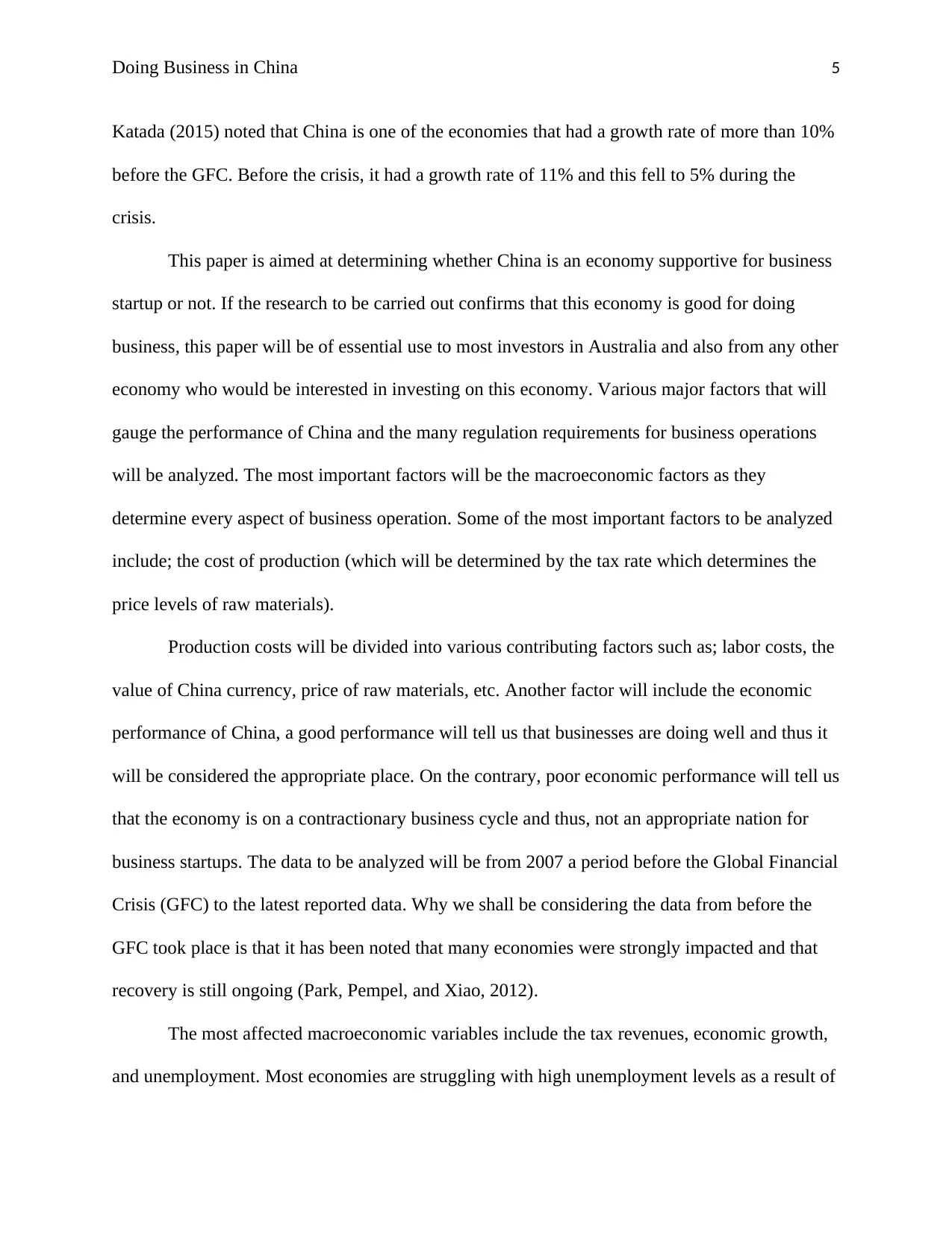
Doing Business in China 5
Katada (2015) noted that China is one of the economies that had a growth rate of more than 10%
before the GFC. Before the crisis, it had a growth rate of 11% and this fell to 5% during the
crisis.
This paper is aimed at determining whether China is an economy supportive for business
startup or not. If the research to be carried out confirms that this economy is good for doing
business, this paper will be of essential use to most investors in Australia and also from any other
economy who would be interested in investing on this economy. Various major factors that will
gauge the performance of China and the many regulation requirements for business operations
will be analyzed. The most important factors will be the macroeconomic factors as they
determine every aspect of business operation. Some of the most important factors to be analyzed
include; the cost of production (which will be determined by the tax rate which determines the
price levels of raw materials).
Production costs will be divided into various contributing factors such as; labor costs, the
value of China currency, price of raw materials, etc. Another factor will include the economic
performance of China, a good performance will tell us that businesses are doing well and thus it
will be considered the appropriate place. On the contrary, poor economic performance will tell us
that the economy is on a contractionary business cycle and thus, not an appropriate nation for
business startups. The data to be analyzed will be from 2007 a period before the Global Financial
Crisis (GFC) to the latest reported data. Why we shall be considering the data from before the
GFC took place is that it has been noted that many economies were strongly impacted and that
recovery is still ongoing (Park, Pempel, and Xiao, 2012).
The most affected macroeconomic variables include the tax revenues, economic growth,
and unemployment. Most economies are struggling with high unemployment levels as a result of
Katada (2015) noted that China is one of the economies that had a growth rate of more than 10%
before the GFC. Before the crisis, it had a growth rate of 11% and this fell to 5% during the
crisis.
This paper is aimed at determining whether China is an economy supportive for business
startup or not. If the research to be carried out confirms that this economy is good for doing
business, this paper will be of essential use to most investors in Australia and also from any other
economy who would be interested in investing on this economy. Various major factors that will
gauge the performance of China and the many regulation requirements for business operations
will be analyzed. The most important factors will be the macroeconomic factors as they
determine every aspect of business operation. Some of the most important factors to be analyzed
include; the cost of production (which will be determined by the tax rate which determines the
price levels of raw materials).
Production costs will be divided into various contributing factors such as; labor costs, the
value of China currency, price of raw materials, etc. Another factor will include the economic
performance of China, a good performance will tell us that businesses are doing well and thus it
will be considered the appropriate place. On the contrary, poor economic performance will tell us
that the economy is on a contractionary business cycle and thus, not an appropriate nation for
business startups. The data to be analyzed will be from 2007 a period before the Global Financial
Crisis (GFC) to the latest reported data. Why we shall be considering the data from before the
GFC took place is that it has been noted that many economies were strongly impacted and that
recovery is still ongoing (Park, Pempel, and Xiao, 2012).
The most affected macroeconomic variables include the tax revenues, economic growth,
and unemployment. Most economies are struggling with high unemployment levels as a result of
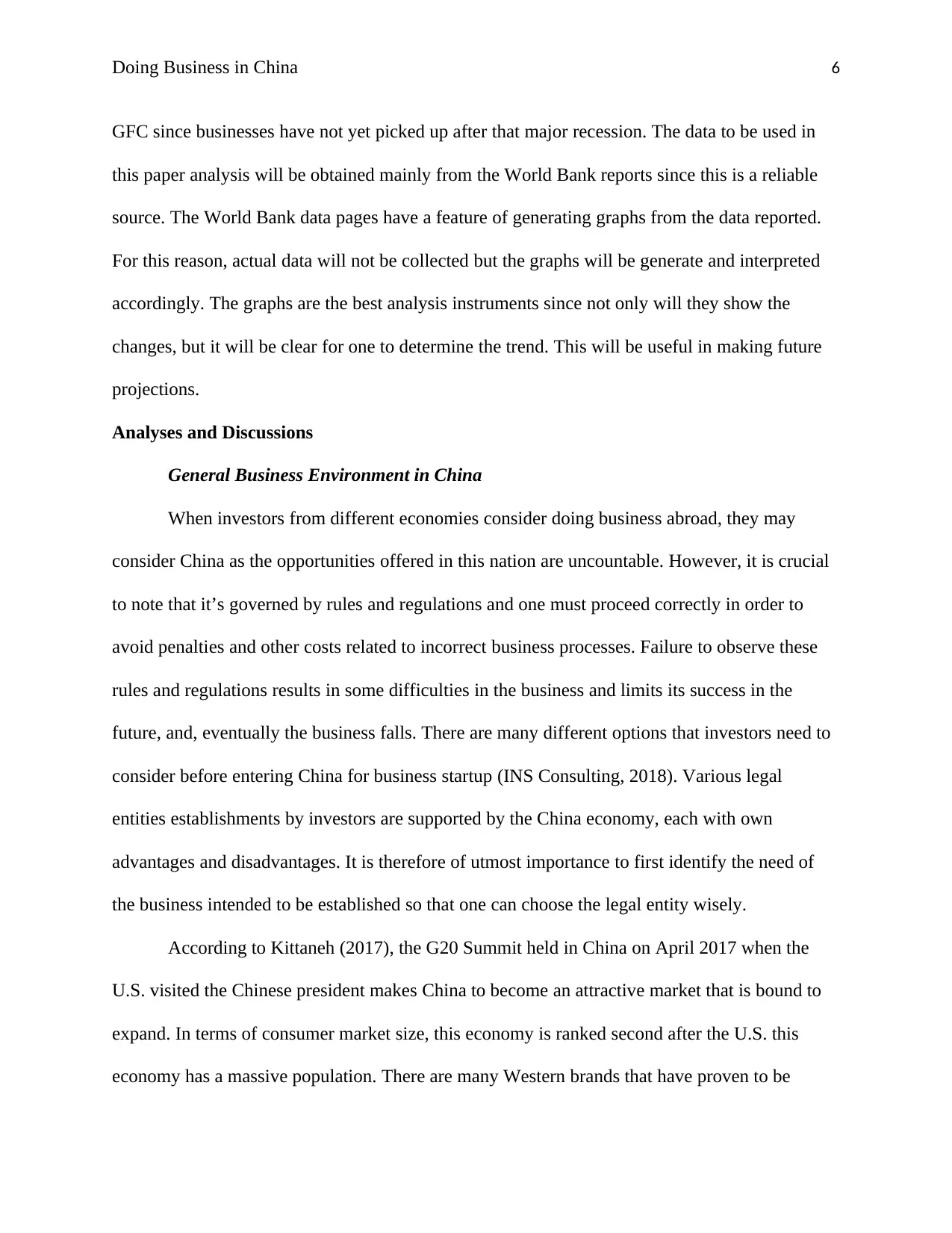
Doing Business in China 6
GFC since businesses have not yet picked up after that major recession. The data to be used in
this paper analysis will be obtained mainly from the World Bank reports since this is a reliable
source. The World Bank data pages have a feature of generating graphs from the data reported.
For this reason, actual data will not be collected but the graphs will be generate and interpreted
accordingly. The graphs are the best analysis instruments since not only will they show the
changes, but it will be clear for one to determine the trend. This will be useful in making future
projections.
Analyses and Discussions
General Business Environment in China
When investors from different economies consider doing business abroad, they may
consider China as the opportunities offered in this nation are uncountable. However, it is crucial
to note that it’s governed by rules and regulations and one must proceed correctly in order to
avoid penalties and other costs related to incorrect business processes. Failure to observe these
rules and regulations results in some difficulties in the business and limits its success in the
future, and, eventually the business falls. There are many different options that investors need to
consider before entering China for business startup (INS Consulting, 2018). Various legal
entities establishments by investors are supported by the China economy, each with own
advantages and disadvantages. It is therefore of utmost importance to first identify the need of
the business intended to be established so that one can choose the legal entity wisely.
According to Kittaneh (2017), the G20 Summit held in China on April 2017 when the
U.S. visited the Chinese president makes China to become an attractive market that is bound to
expand. In terms of consumer market size, this economy is ranked second after the U.S. this
economy has a massive population. There are many Western brands that have proven to be
GFC since businesses have not yet picked up after that major recession. The data to be used in
this paper analysis will be obtained mainly from the World Bank reports since this is a reliable
source. The World Bank data pages have a feature of generating graphs from the data reported.
For this reason, actual data will not be collected but the graphs will be generate and interpreted
accordingly. The graphs are the best analysis instruments since not only will they show the
changes, but it will be clear for one to determine the trend. This will be useful in making future
projections.
Analyses and Discussions
General Business Environment in China
When investors from different economies consider doing business abroad, they may
consider China as the opportunities offered in this nation are uncountable. However, it is crucial
to note that it’s governed by rules and regulations and one must proceed correctly in order to
avoid penalties and other costs related to incorrect business processes. Failure to observe these
rules and regulations results in some difficulties in the business and limits its success in the
future, and, eventually the business falls. There are many different options that investors need to
consider before entering China for business startup (INS Consulting, 2018). Various legal
entities establishments by investors are supported by the China economy, each with own
advantages and disadvantages. It is therefore of utmost importance to first identify the need of
the business intended to be established so that one can choose the legal entity wisely.
According to Kittaneh (2017), the G20 Summit held in China on April 2017 when the
U.S. visited the Chinese president makes China to become an attractive market that is bound to
expand. In terms of consumer market size, this economy is ranked second after the U.S. this
economy has a massive population. There are many Western brands that have proven to be
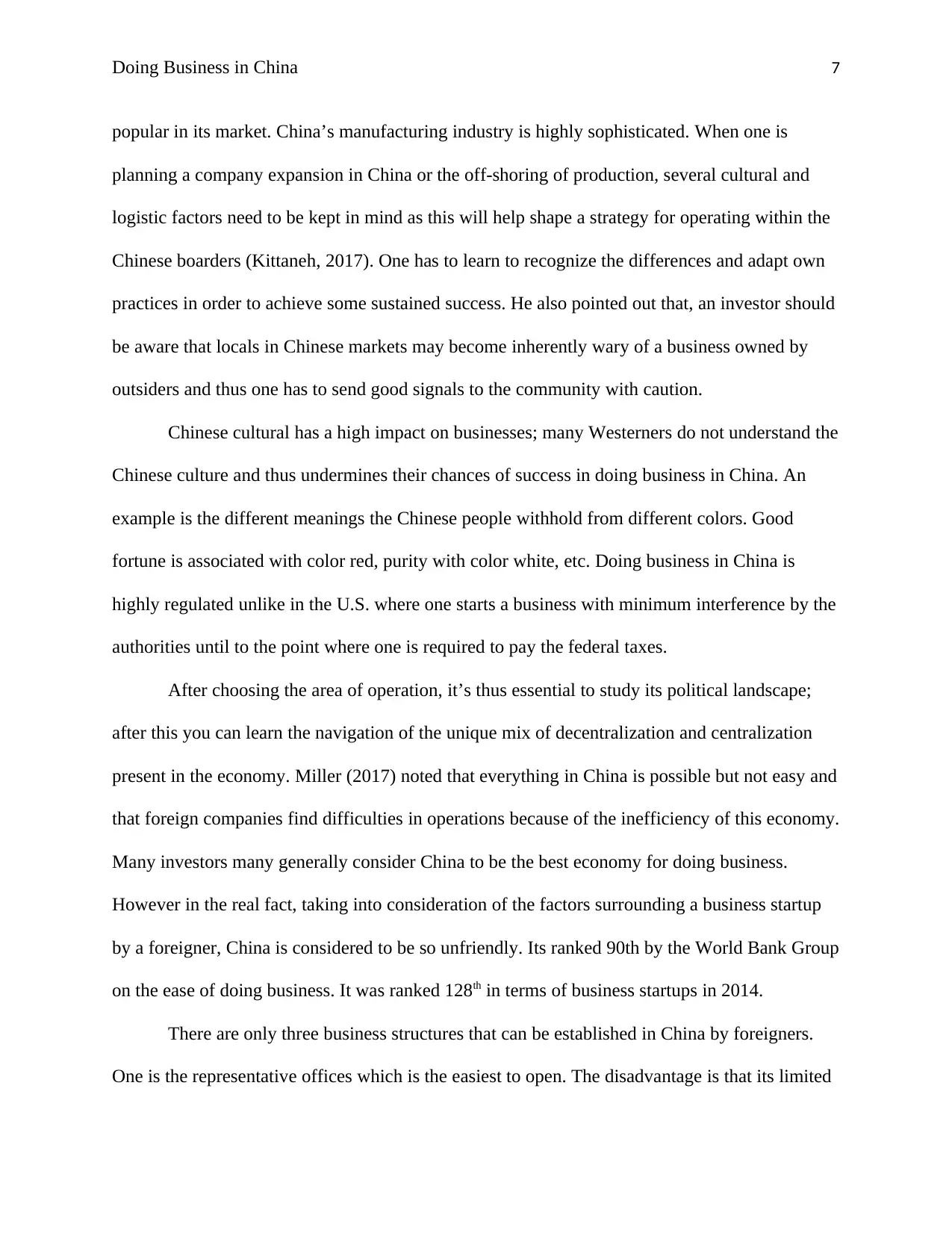
Doing Business in China 7
popular in its market. China’s manufacturing industry is highly sophisticated. When one is
planning a company expansion in China or the off-shoring of production, several cultural and
logistic factors need to be kept in mind as this will help shape a strategy for operating within the
Chinese boarders (Kittaneh, 2017). One has to learn to recognize the differences and adapt own
practices in order to achieve some sustained success. He also pointed out that, an investor should
be aware that locals in Chinese markets may become inherently wary of a business owned by
outsiders and thus one has to send good signals to the community with caution.
Chinese cultural has a high impact on businesses; many Westerners do not understand the
Chinese culture and thus undermines their chances of success in doing business in China. An
example is the different meanings the Chinese people withhold from different colors. Good
fortune is associated with color red, purity with color white, etc. Doing business in China is
highly regulated unlike in the U.S. where one starts a business with minimum interference by the
authorities until to the point where one is required to pay the federal taxes.
After choosing the area of operation, it’s thus essential to study its political landscape;
after this you can learn the navigation of the unique mix of decentralization and centralization
present in the economy. Miller (2017) noted that everything in China is possible but not easy and
that foreign companies find difficulties in operations because of the inefficiency of this economy.
Many investors many generally consider China to be the best economy for doing business.
However in the real fact, taking into consideration of the factors surrounding a business startup
by a foreigner, China is considered to be so unfriendly. Its ranked 90th by the World Bank Group
on the ease of doing business. It was ranked 128th in terms of business startups in 2014.
There are only three business structures that can be established in China by foreigners.
One is the representative offices which is the easiest to open. The disadvantage is that its limited
popular in its market. China’s manufacturing industry is highly sophisticated. When one is
planning a company expansion in China or the off-shoring of production, several cultural and
logistic factors need to be kept in mind as this will help shape a strategy for operating within the
Chinese boarders (Kittaneh, 2017). One has to learn to recognize the differences and adapt own
practices in order to achieve some sustained success. He also pointed out that, an investor should
be aware that locals in Chinese markets may become inherently wary of a business owned by
outsiders and thus one has to send good signals to the community with caution.
Chinese cultural has a high impact on businesses; many Westerners do not understand the
Chinese culture and thus undermines their chances of success in doing business in China. An
example is the different meanings the Chinese people withhold from different colors. Good
fortune is associated with color red, purity with color white, etc. Doing business in China is
highly regulated unlike in the U.S. where one starts a business with minimum interference by the
authorities until to the point where one is required to pay the federal taxes.
After choosing the area of operation, it’s thus essential to study its political landscape;
after this you can learn the navigation of the unique mix of decentralization and centralization
present in the economy. Miller (2017) noted that everything in China is possible but not easy and
that foreign companies find difficulties in operations because of the inefficiency of this economy.
Many investors many generally consider China to be the best economy for doing business.
However in the real fact, taking into consideration of the factors surrounding a business startup
by a foreigner, China is considered to be so unfriendly. Its ranked 90th by the World Bank Group
on the ease of doing business. It was ranked 128th in terms of business startups in 2014.
There are only three business structures that can be established in China by foreigners.
One is the representative offices which is the easiest to open. The disadvantage is that its limited
Paraphrase This Document
Need a fresh take? Get an instant paraphrase of this document with our AI Paraphraser
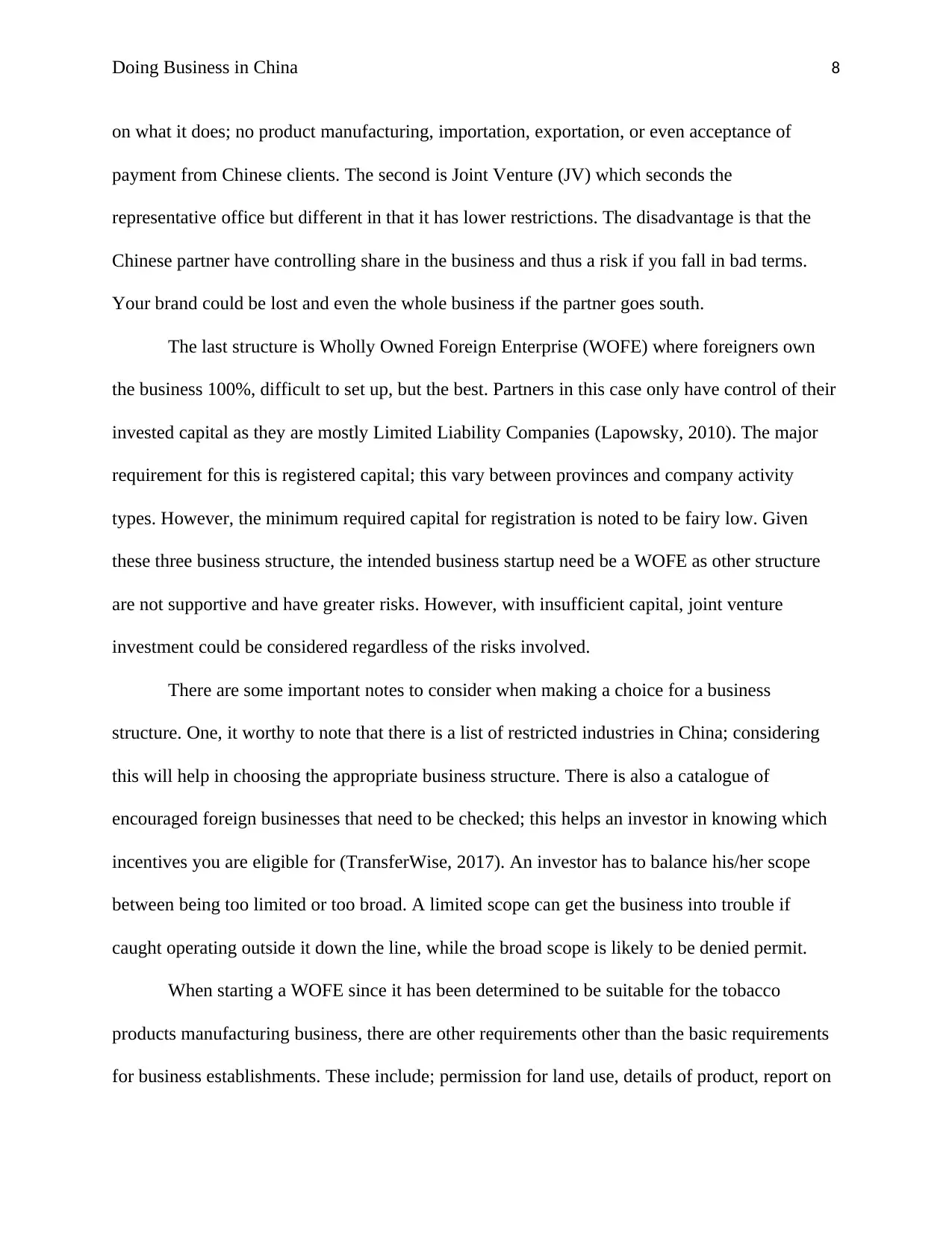
Doing Business in China 8
on what it does; no product manufacturing, importation, exportation, or even acceptance of
payment from Chinese clients. The second is Joint Venture (JV) which seconds the
representative office but different in that it has lower restrictions. The disadvantage is that the
Chinese partner have controlling share in the business and thus a risk if you fall in bad terms.
Your brand could be lost and even the whole business if the partner goes south.
The last structure is Wholly Owned Foreign Enterprise (WOFE) where foreigners own
the business 100%, difficult to set up, but the best. Partners in this case only have control of their
invested capital as they are mostly Limited Liability Companies (Lapowsky, 2010). The major
requirement for this is registered capital; this vary between provinces and company activity
types. However, the minimum required capital for registration is noted to be fairy low. Given
these three business structure, the intended business startup need be a WOFE as other structure
are not supportive and have greater risks. However, with insufficient capital, joint venture
investment could be considered regardless of the risks involved.
There are some important notes to consider when making a choice for a business
structure. One, it worthy to note that there is a list of restricted industries in China; considering
this will help in choosing the appropriate business structure. There is also a catalogue of
encouraged foreign businesses that need to be checked; this helps an investor in knowing which
incentives you are eligible for (TransferWise, 2017). An investor has to balance his/her scope
between being too limited or too broad. A limited scope can get the business into trouble if
caught operating outside it down the line, while the broad scope is likely to be denied permit.
When starting a WOFE since it has been determined to be suitable for the tobacco
products manufacturing business, there are other requirements other than the basic requirements
for business establishments. These include; permission for land use, details of product, report on
on what it does; no product manufacturing, importation, exportation, or even acceptance of
payment from Chinese clients. The second is Joint Venture (JV) which seconds the
representative office but different in that it has lower restrictions. The disadvantage is that the
Chinese partner have controlling share in the business and thus a risk if you fall in bad terms.
Your brand could be lost and even the whole business if the partner goes south.
The last structure is Wholly Owned Foreign Enterprise (WOFE) where foreigners own
the business 100%, difficult to set up, but the best. Partners in this case only have control of their
invested capital as they are mostly Limited Liability Companies (Lapowsky, 2010). The major
requirement for this is registered capital; this vary between provinces and company activity
types. However, the minimum required capital for registration is noted to be fairy low. Given
these three business structure, the intended business startup need be a WOFE as other structure
are not supportive and have greater risks. However, with insufficient capital, joint venture
investment could be considered regardless of the risks involved.
There are some important notes to consider when making a choice for a business
structure. One, it worthy to note that there is a list of restricted industries in China; considering
this will help in choosing the appropriate business structure. There is also a catalogue of
encouraged foreign businesses that need to be checked; this helps an investor in knowing which
incentives you are eligible for (TransferWise, 2017). An investor has to balance his/her scope
between being too limited or too broad. A limited scope can get the business into trouble if
caught operating outside it down the line, while the broad scope is likely to be denied permit.
When starting a WOFE since it has been determined to be suitable for the tobacco
products manufacturing business, there are other requirements other than the basic requirements
for business establishments. These include; permission for land use, details of product, report on
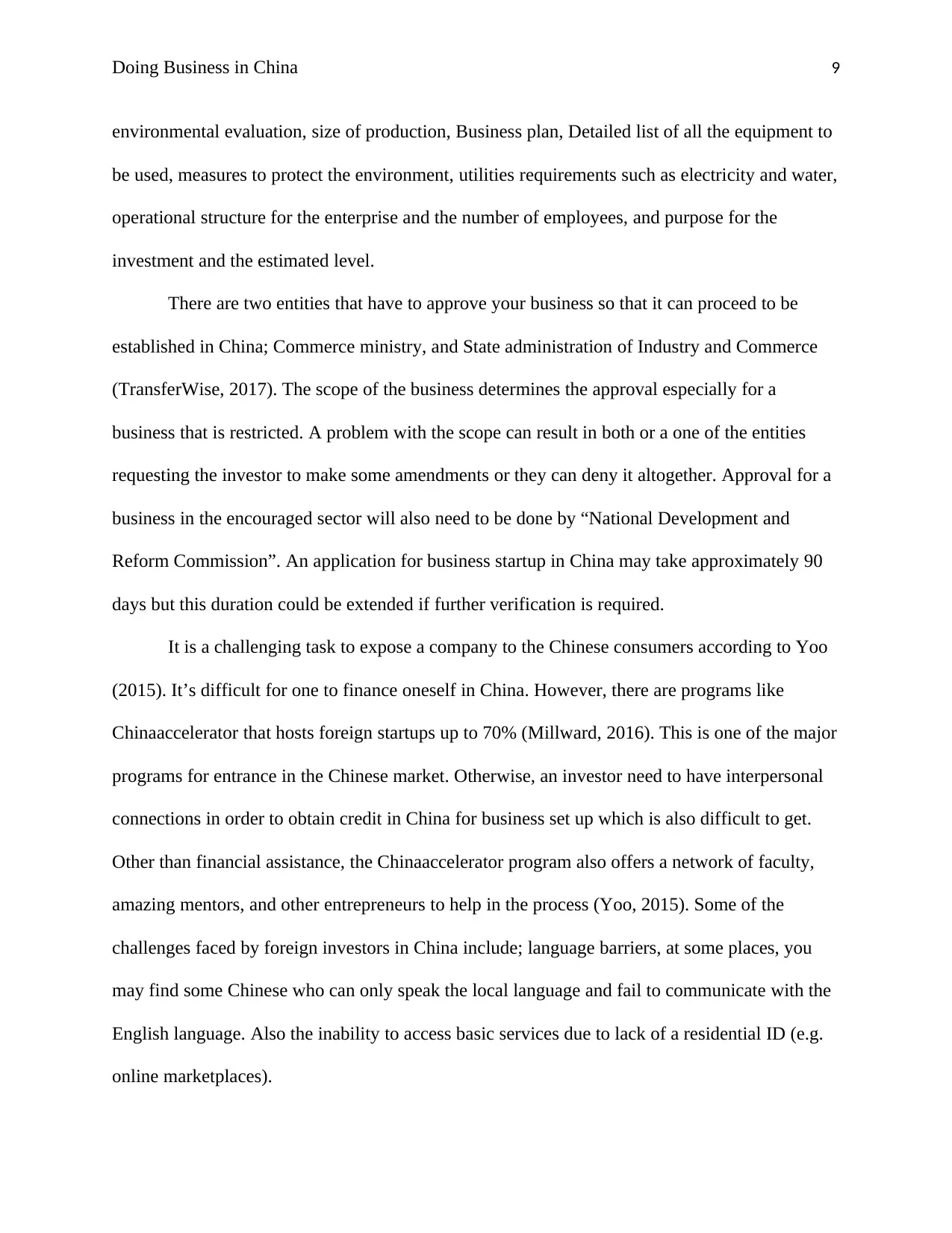
Doing Business in China 9
environmental evaluation, size of production, Business plan, Detailed list of all the equipment to
be used, measures to protect the environment, utilities requirements such as electricity and water,
operational structure for the enterprise and the number of employees, and purpose for the
investment and the estimated level.
There are two entities that have to approve your business so that it can proceed to be
established in China; Commerce ministry, and State administration of Industry and Commerce
(TransferWise, 2017). The scope of the business determines the approval especially for a
business that is restricted. A problem with the scope can result in both or a one of the entities
requesting the investor to make some amendments or they can deny it altogether. Approval for a
business in the encouraged sector will also need to be done by “National Development and
Reform Commission”. An application for business startup in China may take approximately 90
days but this duration could be extended if further verification is required.
It is a challenging task to expose a company to the Chinese consumers according to Yoo
(2015). It’s difficult for one to finance oneself in China. However, there are programs like
Chinaaccelerator that hosts foreign startups up to 70% (Millward, 2016). This is one of the major
programs for entrance in the Chinese market. Otherwise, an investor need to have interpersonal
connections in order to obtain credit in China for business set up which is also difficult to get.
Other than financial assistance, the Chinaaccelerator program also offers a network of faculty,
amazing mentors, and other entrepreneurs to help in the process (Yoo, 2015). Some of the
challenges faced by foreign investors in China include; language barriers, at some places, you
may find some Chinese who can only speak the local language and fail to communicate with the
English language. Also the inability to access basic services due to lack of a residential ID (e.g.
online marketplaces).
environmental evaluation, size of production, Business plan, Detailed list of all the equipment to
be used, measures to protect the environment, utilities requirements such as electricity and water,
operational structure for the enterprise and the number of employees, and purpose for the
investment and the estimated level.
There are two entities that have to approve your business so that it can proceed to be
established in China; Commerce ministry, and State administration of Industry and Commerce
(TransferWise, 2017). The scope of the business determines the approval especially for a
business that is restricted. A problem with the scope can result in both or a one of the entities
requesting the investor to make some amendments or they can deny it altogether. Approval for a
business in the encouraged sector will also need to be done by “National Development and
Reform Commission”. An application for business startup in China may take approximately 90
days but this duration could be extended if further verification is required.
It is a challenging task to expose a company to the Chinese consumers according to Yoo
(2015). It’s difficult for one to finance oneself in China. However, there are programs like
Chinaaccelerator that hosts foreign startups up to 70% (Millward, 2016). This is one of the major
programs for entrance in the Chinese market. Otherwise, an investor need to have interpersonal
connections in order to obtain credit in China for business set up which is also difficult to get.
Other than financial assistance, the Chinaaccelerator program also offers a network of faculty,
amazing mentors, and other entrepreneurs to help in the process (Yoo, 2015). Some of the
challenges faced by foreign investors in China include; language barriers, at some places, you
may find some Chinese who can only speak the local language and fail to communicate with the
English language. Also the inability to access basic services due to lack of a residential ID (e.g.
online marketplaces).
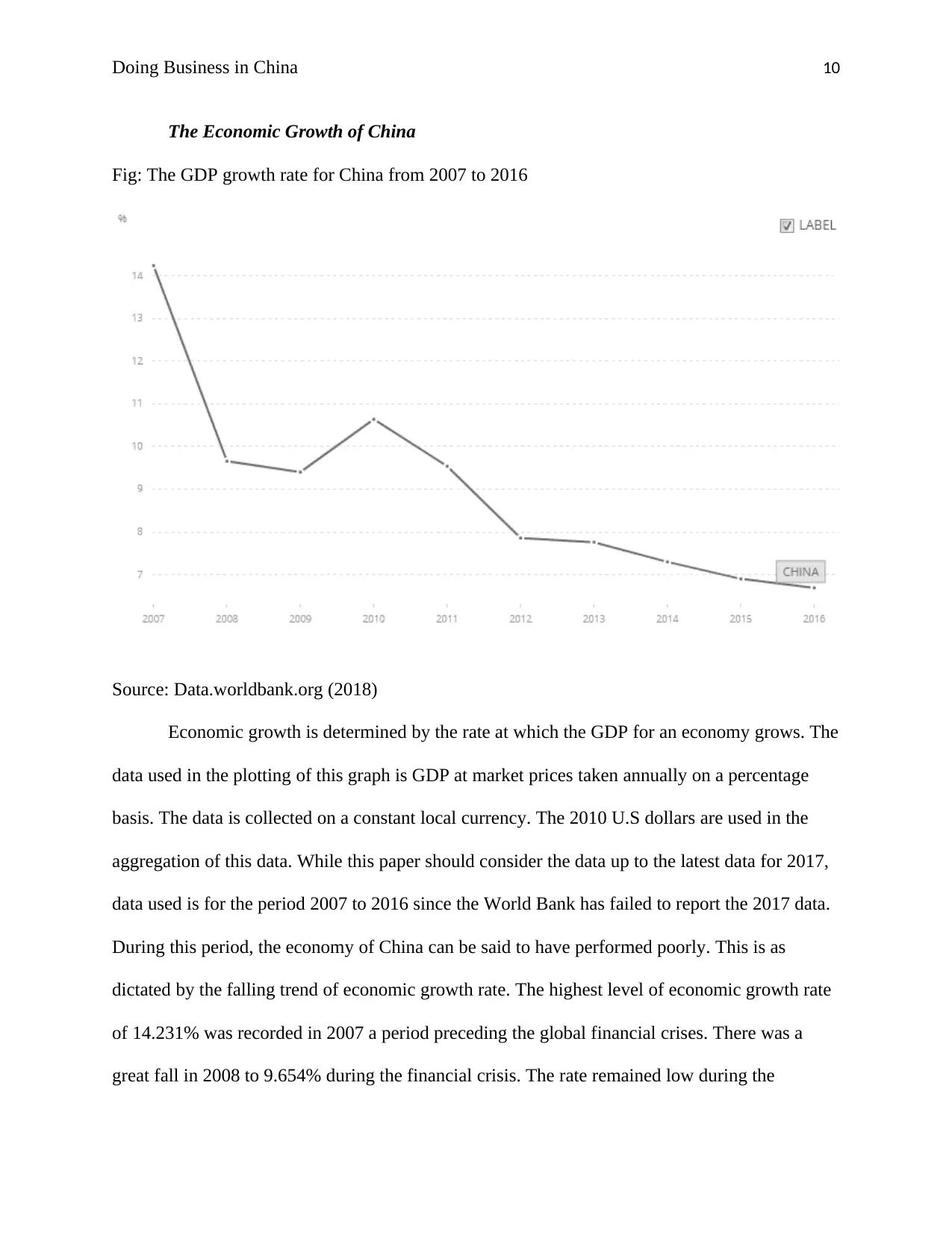
Doing Business in China 10
The Economic Growth of China
Fig: The GDP growth rate for China from 2007 to 2016
Source: Data.worldbank.org (2018)
Economic growth is determined by the rate at which the GDP for an economy grows. The
data used in the plotting of this graph is GDP at market prices taken annually on a percentage
basis. The data is collected on a constant local currency. The 2010 U.S dollars are used in the
aggregation of this data. While this paper should consider the data up to the latest data for 2017,
data used is for the period 2007 to 2016 since the World Bank has failed to report the 2017 data.
During this period, the economy of China can be said to have performed poorly. This is as
dictated by the falling trend of economic growth rate. The highest level of economic growth rate
of 14.231% was recorded in 2007 a period preceding the global financial crises. There was a
great fall in 2008 to 9.654% during the financial crisis. The rate remained low during the
The Economic Growth of China
Fig: The GDP growth rate for China from 2007 to 2016
Source: Data.worldbank.org (2018)
Economic growth is determined by the rate at which the GDP for an economy grows. The
data used in the plotting of this graph is GDP at market prices taken annually on a percentage
basis. The data is collected on a constant local currency. The 2010 U.S dollars are used in the
aggregation of this data. While this paper should consider the data up to the latest data for 2017,
data used is for the period 2007 to 2016 since the World Bank has failed to report the 2017 data.
During this period, the economy of China can be said to have performed poorly. This is as
dictated by the falling trend of economic growth rate. The highest level of economic growth rate
of 14.231% was recorded in 2007 a period preceding the global financial crises. There was a
great fall in 2008 to 9.654% during the financial crisis. The rate remained low during the
Secure Best Marks with AI Grader
Need help grading? Try our AI Grader for instant feedback on your assignments.
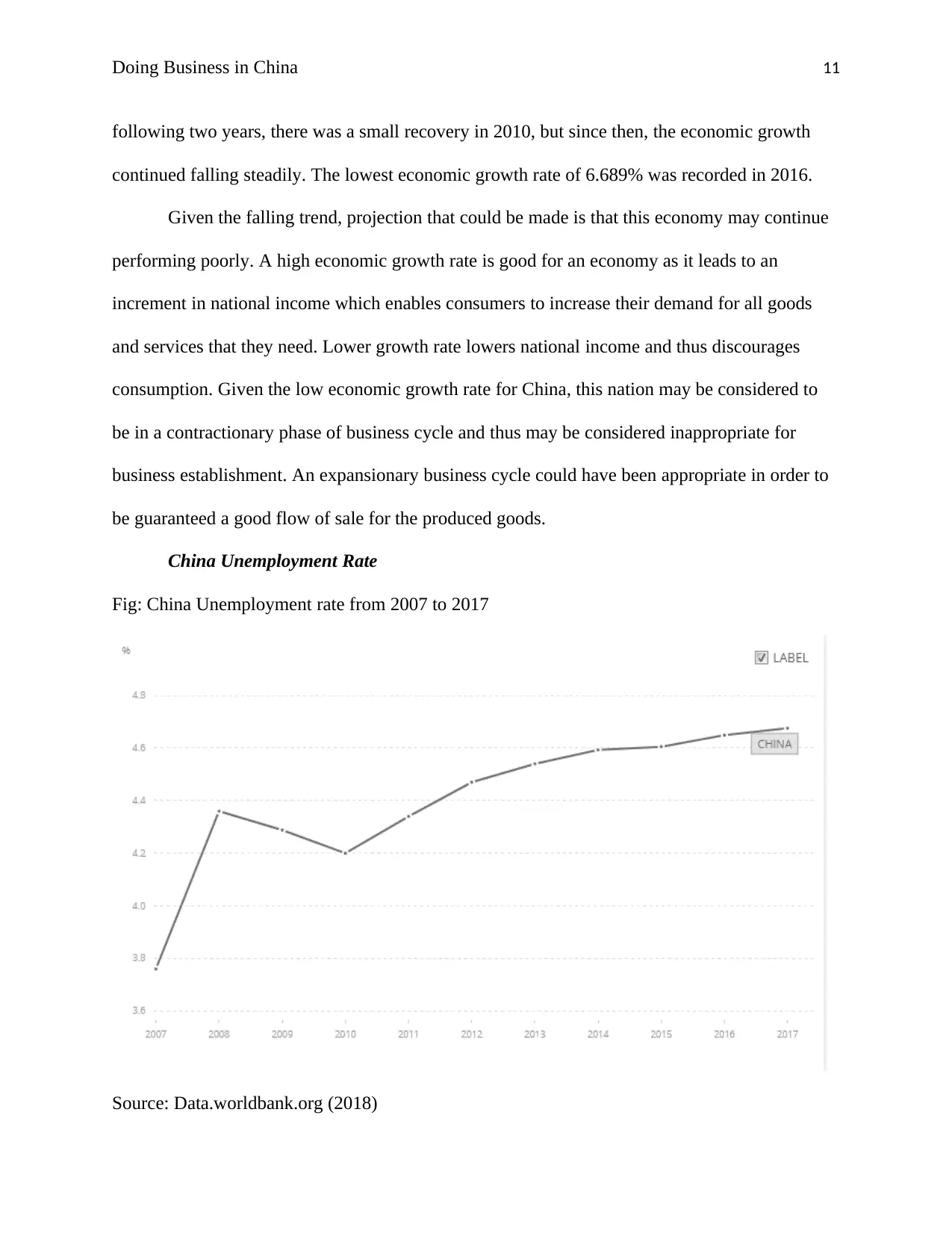
Doing Business in China 11
following two years, there was a small recovery in 2010, but since then, the economic growth
continued falling steadily. The lowest economic growth rate of 6.689% was recorded in 2016.
Given the falling trend, projection that could be made is that this economy may continue
performing poorly. A high economic growth rate is good for an economy as it leads to an
increment in national income which enables consumers to increase their demand for all goods
and services that they need. Lower growth rate lowers national income and thus discourages
consumption. Given the low economic growth rate for China, this nation may be considered to
be in a contractionary phase of business cycle and thus may be considered inappropriate for
business establishment. An expansionary business cycle could have been appropriate in order to
be guaranteed a good flow of sale for the produced goods.
China Unemployment Rate
Fig: China Unemployment rate from 2007 to 2017
Source: Data.worldbank.org (2018)
following two years, there was a small recovery in 2010, but since then, the economic growth
continued falling steadily. The lowest economic growth rate of 6.689% was recorded in 2016.
Given the falling trend, projection that could be made is that this economy may continue
performing poorly. A high economic growth rate is good for an economy as it leads to an
increment in national income which enables consumers to increase their demand for all goods
and services that they need. Lower growth rate lowers national income and thus discourages
consumption. Given the low economic growth rate for China, this nation may be considered to
be in a contractionary phase of business cycle and thus may be considered inappropriate for
business establishment. An expansionary business cycle could have been appropriate in order to
be guaranteed a good flow of sale for the produced goods.
China Unemployment Rate
Fig: China Unemployment rate from 2007 to 2017
Source: Data.worldbank.org (2018)
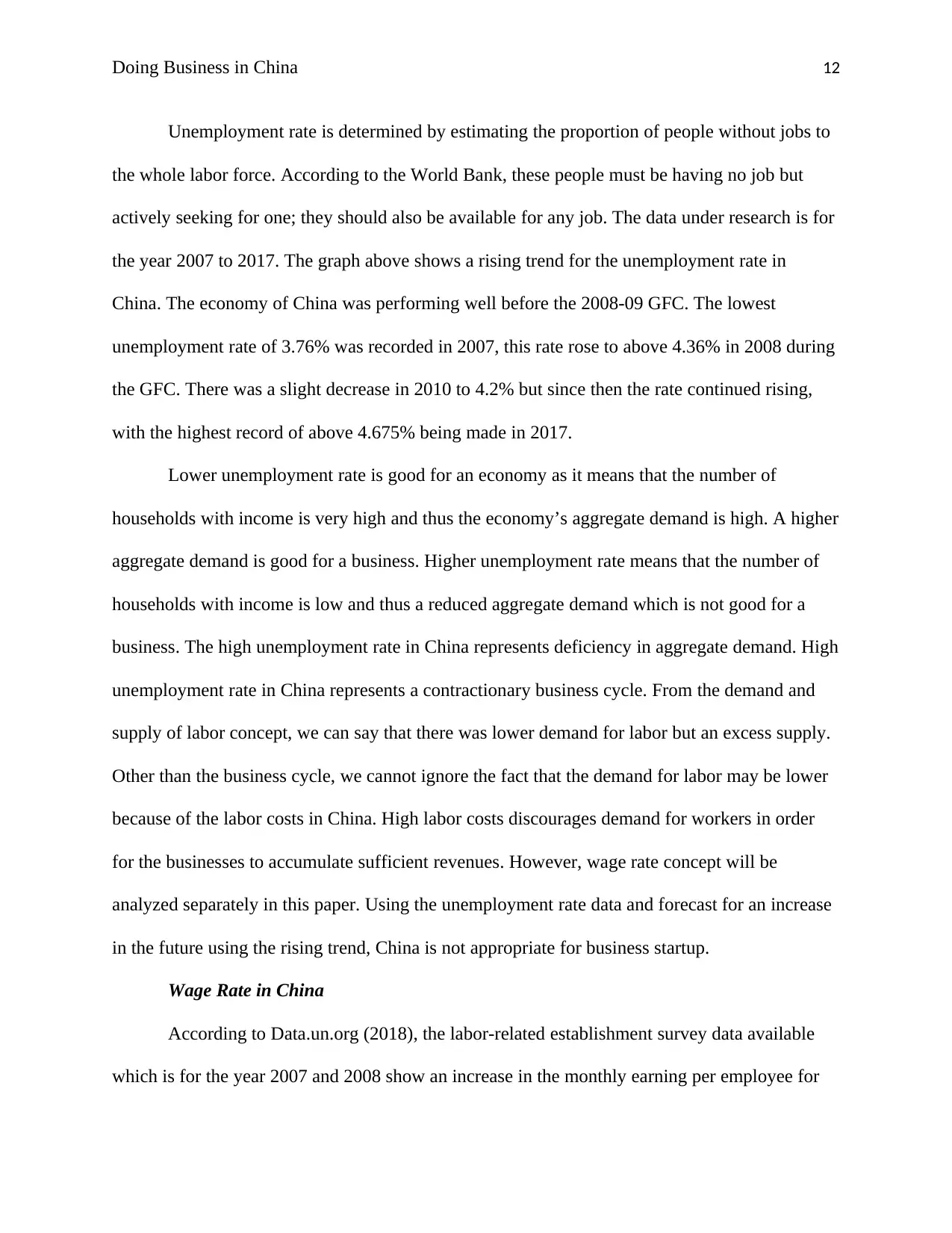
Doing Business in China 12
Unemployment rate is determined by estimating the proportion of people without jobs to
the whole labor force. According to the World Bank, these people must be having no job but
actively seeking for one; they should also be available for any job. The data under research is for
the year 2007 to 2017. The graph above shows a rising trend for the unemployment rate in
China. The economy of China was performing well before the 2008-09 GFC. The lowest
unemployment rate of 3.76% was recorded in 2007, this rate rose to above 4.36% in 2008 during
the GFC. There was a slight decrease in 2010 to 4.2% but since then the rate continued rising,
with the highest record of above 4.675% being made in 2017.
Lower unemployment rate is good for an economy as it means that the number of
households with income is very high and thus the economy’s aggregate demand is high. A higher
aggregate demand is good for a business. Higher unemployment rate means that the number of
households with income is low and thus a reduced aggregate demand which is not good for a
business. The high unemployment rate in China represents deficiency in aggregate demand. High
unemployment rate in China represents a contractionary business cycle. From the demand and
supply of labor concept, we can say that there was lower demand for labor but an excess supply.
Other than the business cycle, we cannot ignore the fact that the demand for labor may be lower
because of the labor costs in China. High labor costs discourages demand for workers in order
for the businesses to accumulate sufficient revenues. However, wage rate concept will be
analyzed separately in this paper. Using the unemployment rate data and forecast for an increase
in the future using the rising trend, China is not appropriate for business startup.
Wage Rate in China
According to Data.un.org (2018), the labor-related establishment survey data available
which is for the year 2007 and 2008 show an increase in the monthly earning per employee for
Unemployment rate is determined by estimating the proportion of people without jobs to
the whole labor force. According to the World Bank, these people must be having no job but
actively seeking for one; they should also be available for any job. The data under research is for
the year 2007 to 2017. The graph above shows a rising trend for the unemployment rate in
China. The economy of China was performing well before the 2008-09 GFC. The lowest
unemployment rate of 3.76% was recorded in 2007, this rate rose to above 4.36% in 2008 during
the GFC. There was a slight decrease in 2010 to 4.2% but since then the rate continued rising,
with the highest record of above 4.675% being made in 2017.
Lower unemployment rate is good for an economy as it means that the number of
households with income is very high and thus the economy’s aggregate demand is high. A higher
aggregate demand is good for a business. Higher unemployment rate means that the number of
households with income is low and thus a reduced aggregate demand which is not good for a
business. The high unemployment rate in China represents deficiency in aggregate demand. High
unemployment rate in China represents a contractionary business cycle. From the demand and
supply of labor concept, we can say that there was lower demand for labor but an excess supply.
Other than the business cycle, we cannot ignore the fact that the demand for labor may be lower
because of the labor costs in China. High labor costs discourages demand for workers in order
for the businesses to accumulate sufficient revenues. However, wage rate concept will be
analyzed separately in this paper. Using the unemployment rate data and forecast for an increase
in the future using the rising trend, China is not appropriate for business startup.
Wage Rate in China
According to Data.un.org (2018), the labor-related establishment survey data available
which is for the year 2007 and 2008 show an increase in the monthly earning per employee for
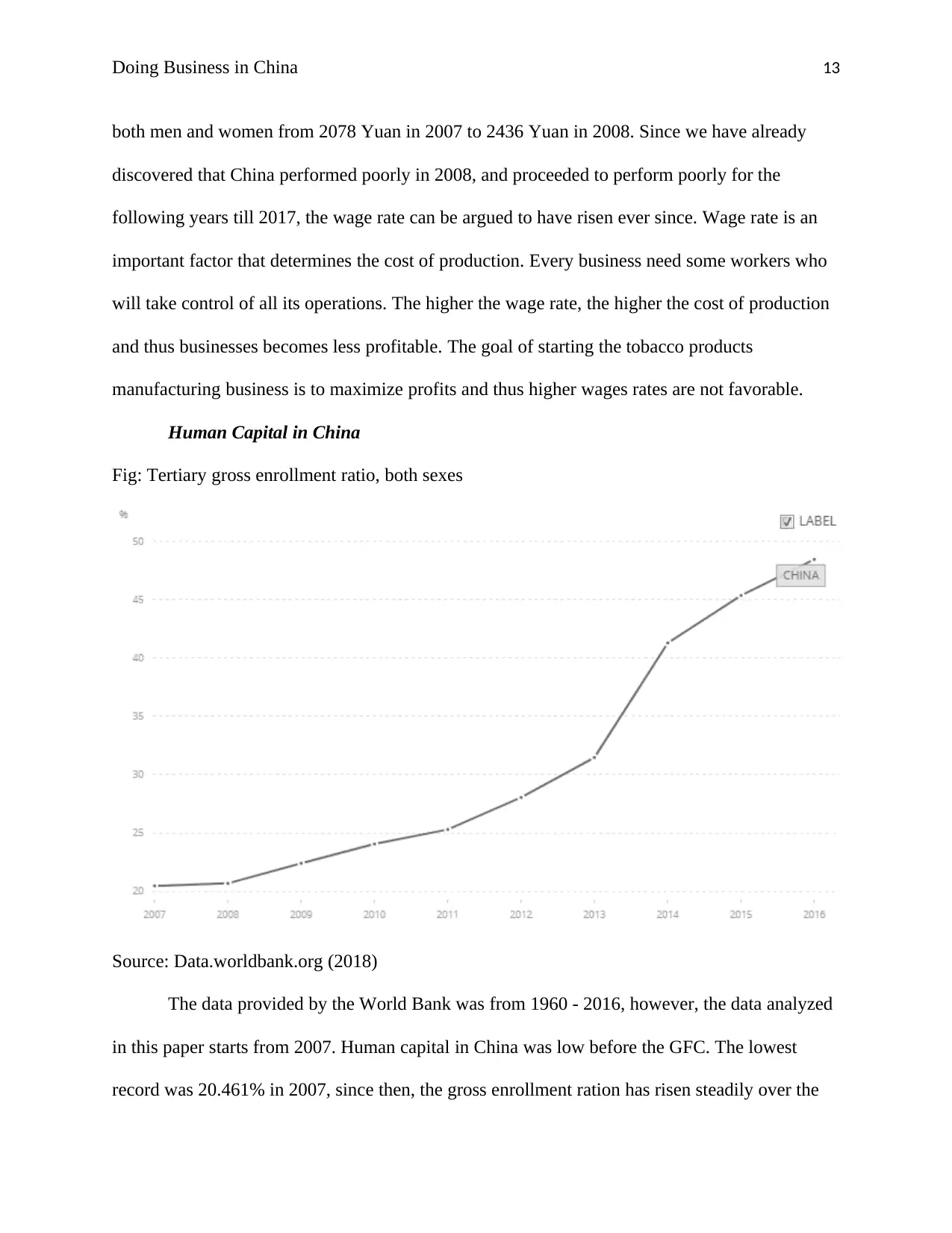
Doing Business in China 13
both men and women from 2078 Yuan in 2007 to 2436 Yuan in 2008. Since we have already
discovered that China performed poorly in 2008, and proceeded to perform poorly for the
following years till 2017, the wage rate can be argued to have risen ever since. Wage rate is an
important factor that determines the cost of production. Every business need some workers who
will take control of all its operations. The higher the wage rate, the higher the cost of production
and thus businesses becomes less profitable. The goal of starting the tobacco products
manufacturing business is to maximize profits and thus higher wages rates are not favorable.
Human Capital in China
Fig: Tertiary gross enrollment ratio, both sexes
Source: Data.worldbank.org (2018)
The data provided by the World Bank was from 1960 - 2016, however, the data analyzed
in this paper starts from 2007. Human capital in China was low before the GFC. The lowest
record was 20.461% in 2007, since then, the gross enrollment ration has risen steadily over the
both men and women from 2078 Yuan in 2007 to 2436 Yuan in 2008. Since we have already
discovered that China performed poorly in 2008, and proceeded to perform poorly for the
following years till 2017, the wage rate can be argued to have risen ever since. Wage rate is an
important factor that determines the cost of production. Every business need some workers who
will take control of all its operations. The higher the wage rate, the higher the cost of production
and thus businesses becomes less profitable. The goal of starting the tobacco products
manufacturing business is to maximize profits and thus higher wages rates are not favorable.
Human Capital in China
Fig: Tertiary gross enrollment ratio, both sexes
Source: Data.worldbank.org (2018)
The data provided by the World Bank was from 1960 - 2016, however, the data analyzed
in this paper starts from 2007. Human capital in China was low before the GFC. The lowest
record was 20.461% in 2007, since then, the gross enrollment ration has risen steadily over the
Paraphrase This Document
Need a fresh take? Get an instant paraphrase of this document with our AI Paraphraser
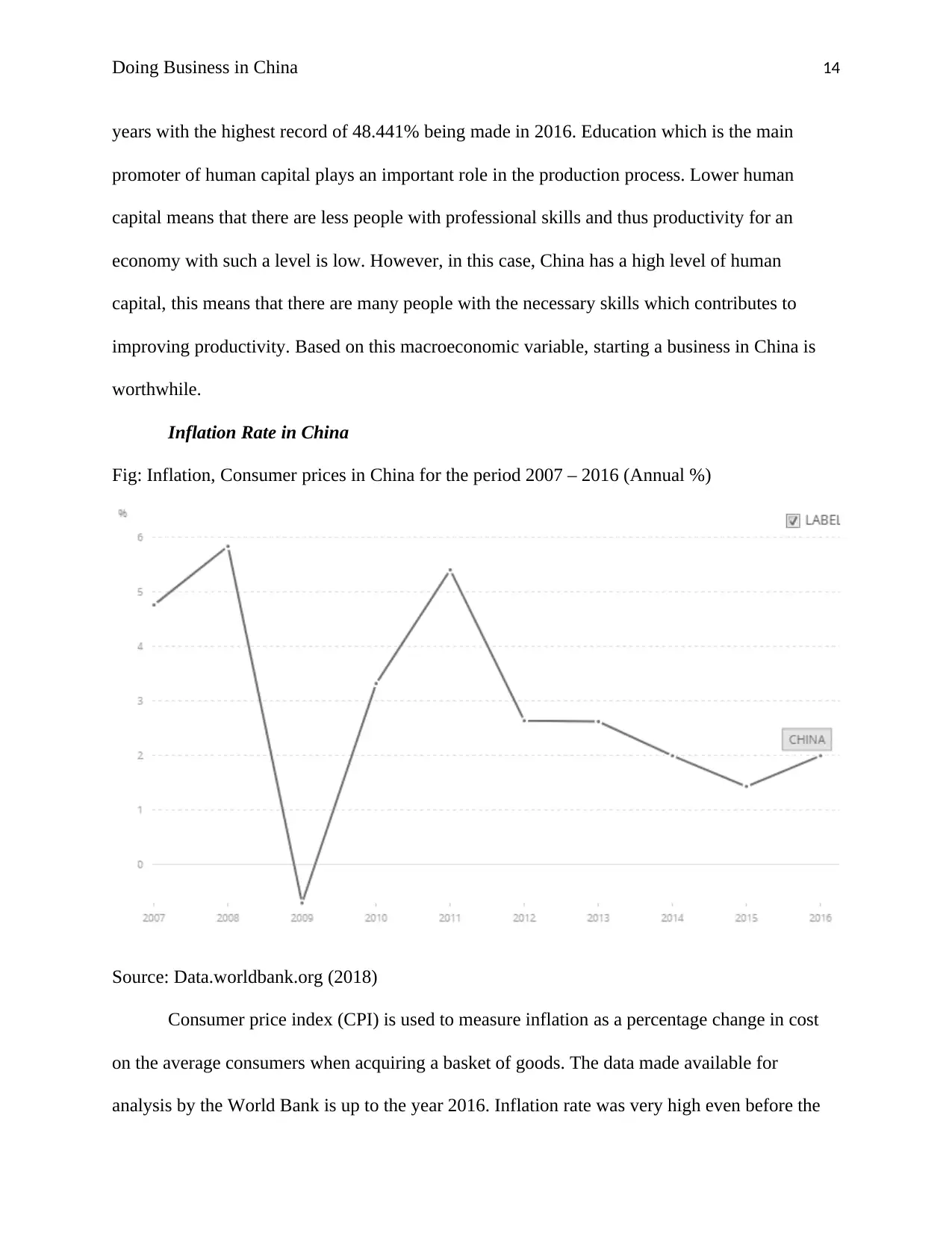
Doing Business in China 14
years with the highest record of 48.441% being made in 2016. Education which is the main
promoter of human capital plays an important role in the production process. Lower human
capital means that there are less people with professional skills and thus productivity for an
economy with such a level is low. However, in this case, China has a high level of human
capital, this means that there are many people with the necessary skills which contributes to
improving productivity. Based on this macroeconomic variable, starting a business in China is
worthwhile.
Inflation Rate in China
Fig: Inflation, Consumer prices in China for the period 2007 – 2016 (Annual %)
Source: Data.worldbank.org (2018)
Consumer price index (CPI) is used to measure inflation as a percentage change in cost
on the average consumers when acquiring a basket of goods. The data made available for
analysis by the World Bank is up to the year 2016. Inflation rate was very high even before the
years with the highest record of 48.441% being made in 2016. Education which is the main
promoter of human capital plays an important role in the production process. Lower human
capital means that there are less people with professional skills and thus productivity for an
economy with such a level is low. However, in this case, China has a high level of human
capital, this means that there are many people with the necessary skills which contributes to
improving productivity. Based on this macroeconomic variable, starting a business in China is
worthwhile.
Inflation Rate in China
Fig: Inflation, Consumer prices in China for the period 2007 – 2016 (Annual %)
Source: Data.worldbank.org (2018)
Consumer price index (CPI) is used to measure inflation as a percentage change in cost
on the average consumers when acquiring a basket of goods. The data made available for
analysis by the World Bank is up to the year 2016. Inflation rate was very high even before the
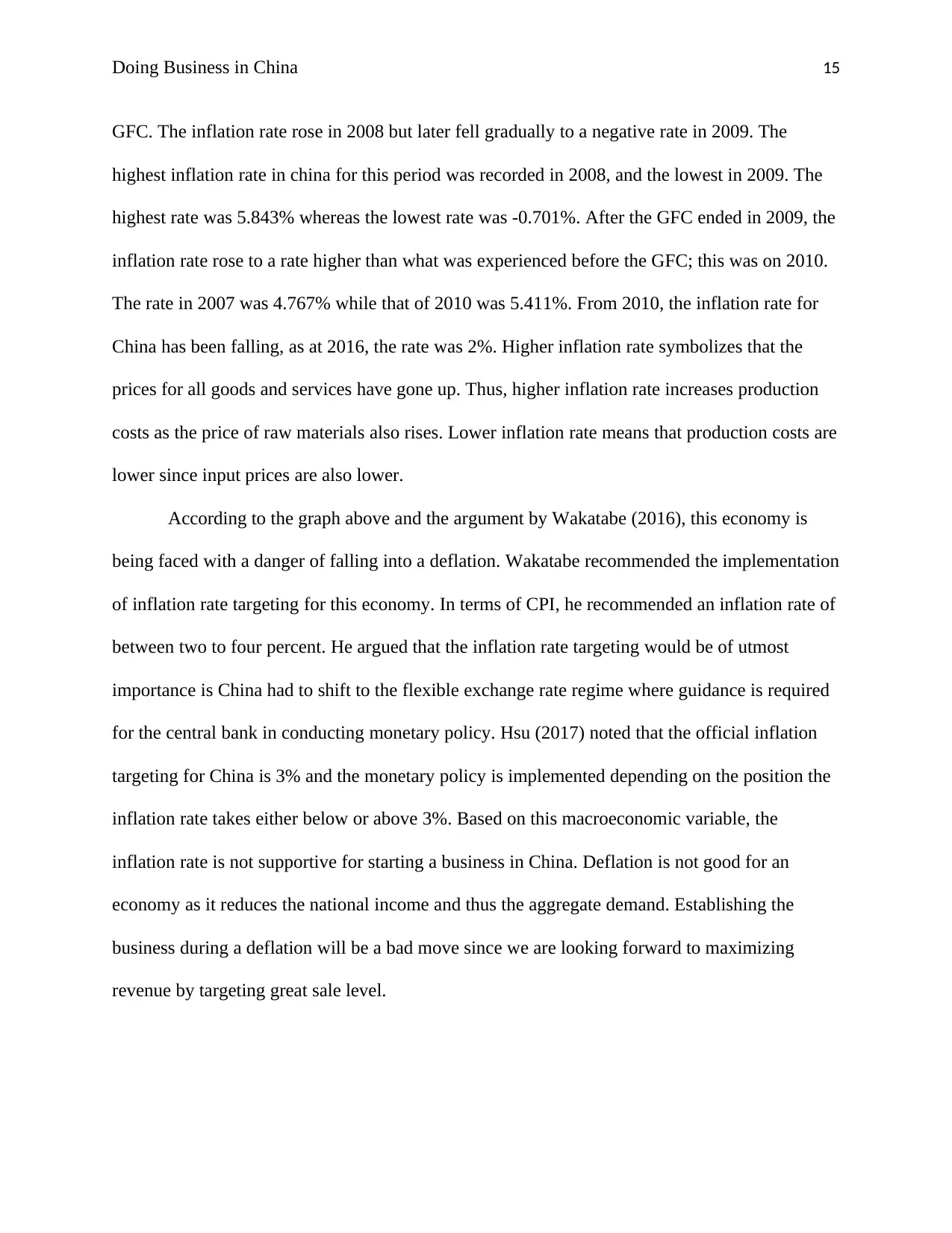
Doing Business in China 15
GFC. The inflation rate rose in 2008 but later fell gradually to a negative rate in 2009. The
highest inflation rate in china for this period was recorded in 2008, and the lowest in 2009. The
highest rate was 5.843% whereas the lowest rate was -0.701%. After the GFC ended in 2009, the
inflation rate rose to a rate higher than what was experienced before the GFC; this was on 2010.
The rate in 2007 was 4.767% while that of 2010 was 5.411%. From 2010, the inflation rate for
China has been falling, as at 2016, the rate was 2%. Higher inflation rate symbolizes that the
prices for all goods and services have gone up. Thus, higher inflation rate increases production
costs as the price of raw materials also rises. Lower inflation rate means that production costs are
lower since input prices are also lower.
According to the graph above and the argument by Wakatabe (2016), this economy is
being faced with a danger of falling into a deflation. Wakatabe recommended the implementation
of inflation rate targeting for this economy. In terms of CPI, he recommended an inflation rate of
between two to four percent. He argued that the inflation rate targeting would be of utmost
importance is China had to shift to the flexible exchange rate regime where guidance is required
for the central bank in conducting monetary policy. Hsu (2017) noted that the official inflation
targeting for China is 3% and the monetary policy is implemented depending on the position the
inflation rate takes either below or above 3%. Based on this macroeconomic variable, the
inflation rate is not supportive for starting a business in China. Deflation is not good for an
economy as it reduces the national income and thus the aggregate demand. Establishing the
business during a deflation will be a bad move since we are looking forward to maximizing
revenue by targeting great sale level.
GFC. The inflation rate rose in 2008 but later fell gradually to a negative rate in 2009. The
highest inflation rate in china for this period was recorded in 2008, and the lowest in 2009. The
highest rate was 5.843% whereas the lowest rate was -0.701%. After the GFC ended in 2009, the
inflation rate rose to a rate higher than what was experienced before the GFC; this was on 2010.
The rate in 2007 was 4.767% while that of 2010 was 5.411%. From 2010, the inflation rate for
China has been falling, as at 2016, the rate was 2%. Higher inflation rate symbolizes that the
prices for all goods and services have gone up. Thus, higher inflation rate increases production
costs as the price of raw materials also rises. Lower inflation rate means that production costs are
lower since input prices are also lower.
According to the graph above and the argument by Wakatabe (2016), this economy is
being faced with a danger of falling into a deflation. Wakatabe recommended the implementation
of inflation rate targeting for this economy. In terms of CPI, he recommended an inflation rate of
between two to four percent. He argued that the inflation rate targeting would be of utmost
importance is China had to shift to the flexible exchange rate regime where guidance is required
for the central bank in conducting monetary policy. Hsu (2017) noted that the official inflation
targeting for China is 3% and the monetary policy is implemented depending on the position the
inflation rate takes either below or above 3%. Based on this macroeconomic variable, the
inflation rate is not supportive for starting a business in China. Deflation is not good for an
economy as it reduces the national income and thus the aggregate demand. Establishing the
business during a deflation will be a bad move since we are looking forward to maximizing
revenue by targeting great sale level.
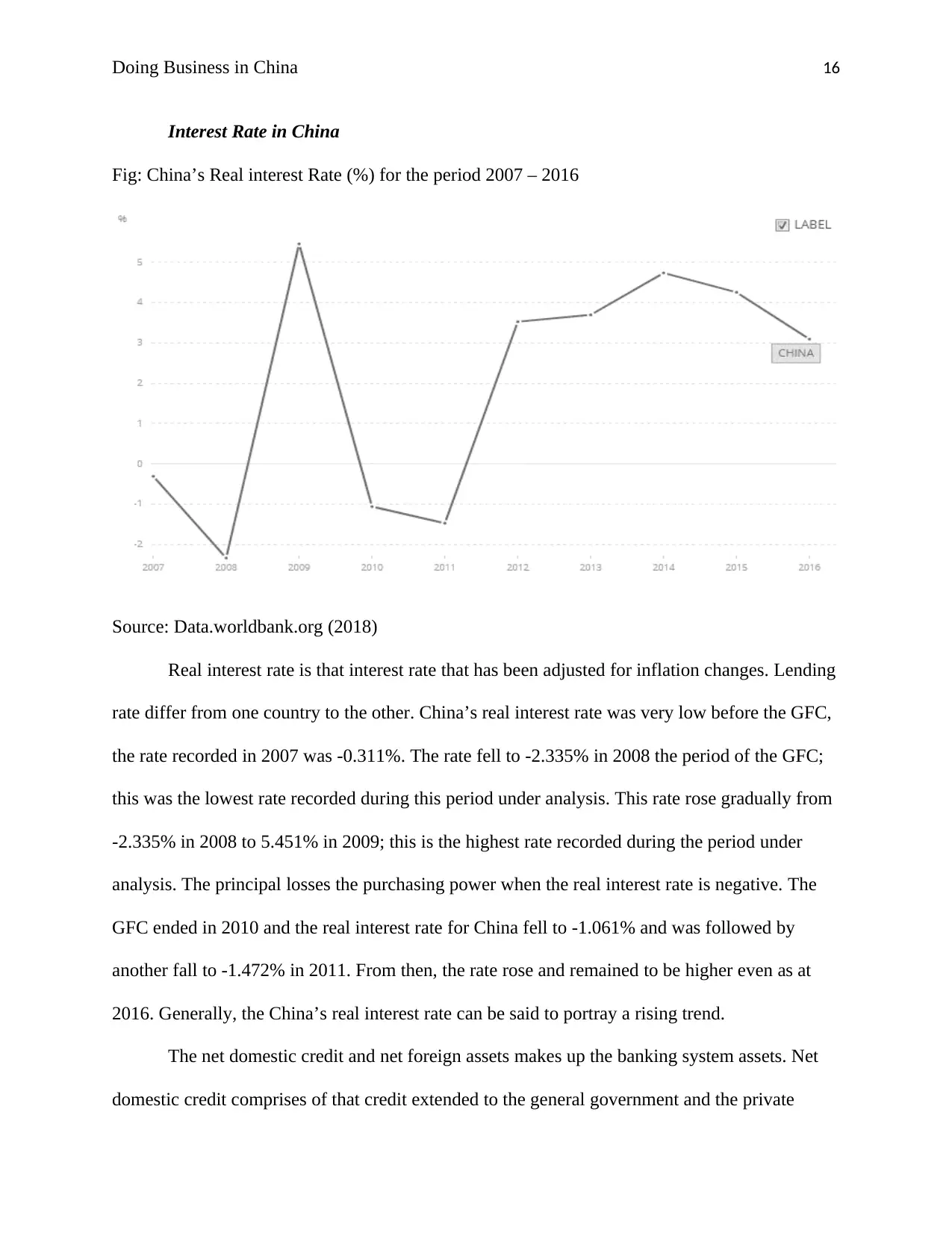
Doing Business in China 16
Interest Rate in China
Fig: China’s Real interest Rate (%) for the period 2007 – 2016
Source: Data.worldbank.org (2018)
Real interest rate is that interest rate that has been adjusted for inflation changes. Lending
rate differ from one country to the other. China’s real interest rate was very low before the GFC,
the rate recorded in 2007 was -0.311%. The rate fell to -2.335% in 2008 the period of the GFC;
this was the lowest rate recorded during this period under analysis. This rate rose gradually from
-2.335% in 2008 to 5.451% in 2009; this is the highest rate recorded during the period under
analysis. The principal losses the purchasing power when the real interest rate is negative. The
GFC ended in 2010 and the real interest rate for China fell to -1.061% and was followed by
another fall to -1.472% in 2011. From then, the rate rose and remained to be higher even as at
2016. Generally, the China’s real interest rate can be said to portray a rising trend.
The net domestic credit and net foreign assets makes up the banking system assets. Net
domestic credit comprises of that credit extended to the general government and the private
Interest Rate in China
Fig: China’s Real interest Rate (%) for the period 2007 – 2016
Source: Data.worldbank.org (2018)
Real interest rate is that interest rate that has been adjusted for inflation changes. Lending
rate differ from one country to the other. China’s real interest rate was very low before the GFC,
the rate recorded in 2007 was -0.311%. The rate fell to -2.335% in 2008 the period of the GFC;
this was the lowest rate recorded during this period under analysis. This rate rose gradually from
-2.335% in 2008 to 5.451% in 2009; this is the highest rate recorded during the period under
analysis. The principal losses the purchasing power when the real interest rate is negative. The
GFC ended in 2010 and the real interest rate for China fell to -1.061% and was followed by
another fall to -1.472% in 2011. From then, the rate rose and remained to be higher even as at
2016. Generally, the China’s real interest rate can be said to portray a rising trend.
The net domestic credit and net foreign assets makes up the banking system assets. Net
domestic credit comprises of that credit extended to the general government and the private
Secure Best Marks with AI Grader
Need help grading? Try our AI Grader for instant feedback on your assignments.
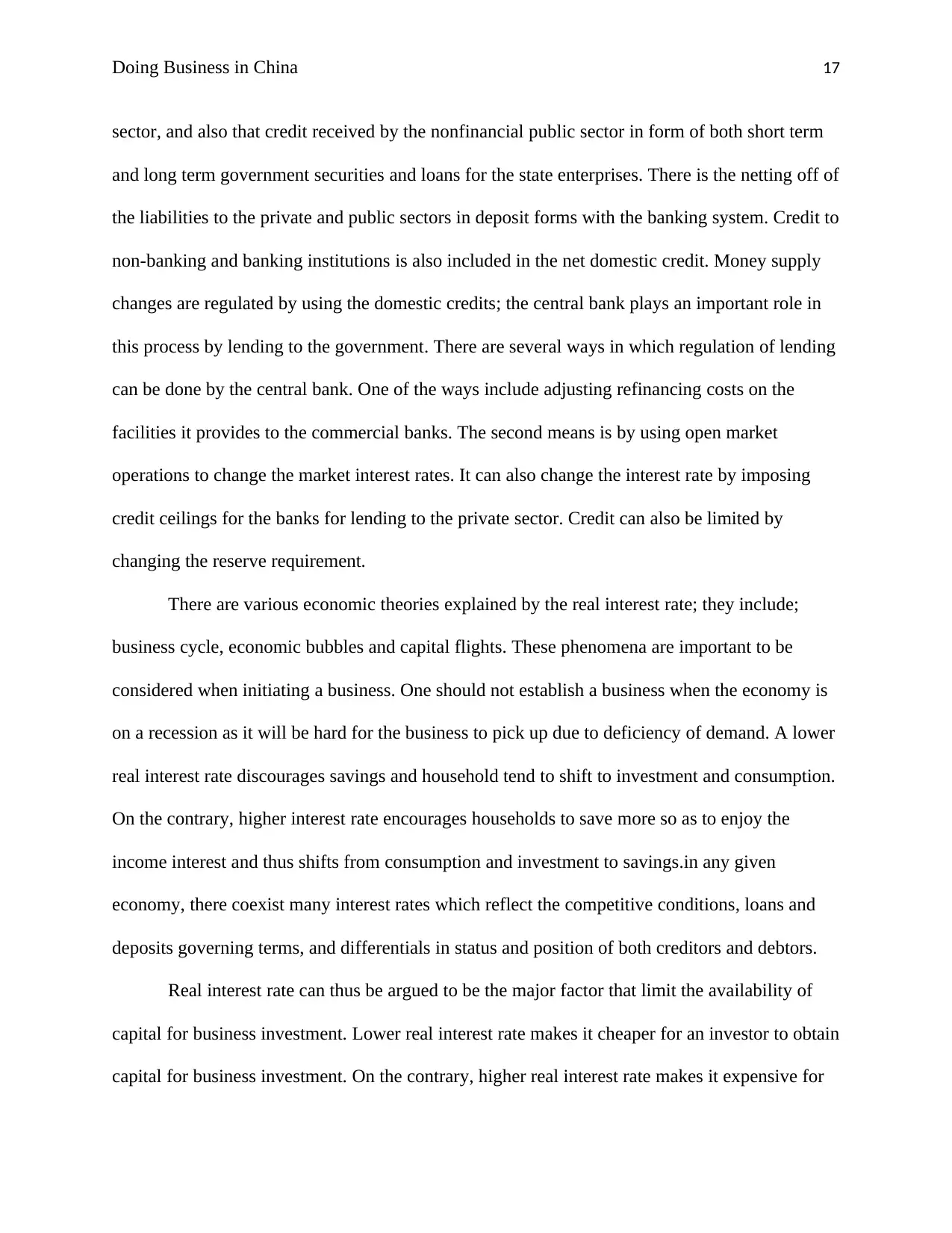
Doing Business in China 17
sector, and also that credit received by the nonfinancial public sector in form of both short term
and long term government securities and loans for the state enterprises. There is the netting off of
the liabilities to the private and public sectors in deposit forms with the banking system. Credit to
non-banking and banking institutions is also included in the net domestic credit. Money supply
changes are regulated by using the domestic credits; the central bank plays an important role in
this process by lending to the government. There are several ways in which regulation of lending
can be done by the central bank. One of the ways include adjusting refinancing costs on the
facilities it provides to the commercial banks. The second means is by using open market
operations to change the market interest rates. It can also change the interest rate by imposing
credit ceilings for the banks for lending to the private sector. Credit can also be limited by
changing the reserve requirement.
There are various economic theories explained by the real interest rate; they include;
business cycle, economic bubbles and capital flights. These phenomena are important to be
considered when initiating a business. One should not establish a business when the economy is
on a recession as it will be hard for the business to pick up due to deficiency of demand. A lower
real interest rate discourages savings and household tend to shift to investment and consumption.
On the contrary, higher interest rate encourages households to save more so as to enjoy the
income interest and thus shifts from consumption and investment to savings.in any given
economy, there coexist many interest rates which reflect the competitive conditions, loans and
deposits governing terms, and differentials in status and position of both creditors and debtors.
Real interest rate can thus be argued to be the major factor that limit the availability of
capital for business investment. Lower real interest rate makes it cheaper for an investor to obtain
capital for business investment. On the contrary, higher real interest rate makes it expensive for
sector, and also that credit received by the nonfinancial public sector in form of both short term
and long term government securities and loans for the state enterprises. There is the netting off of
the liabilities to the private and public sectors in deposit forms with the banking system. Credit to
non-banking and banking institutions is also included in the net domestic credit. Money supply
changes are regulated by using the domestic credits; the central bank plays an important role in
this process by lending to the government. There are several ways in which regulation of lending
can be done by the central bank. One of the ways include adjusting refinancing costs on the
facilities it provides to the commercial banks. The second means is by using open market
operations to change the market interest rates. It can also change the interest rate by imposing
credit ceilings for the banks for lending to the private sector. Credit can also be limited by
changing the reserve requirement.
There are various economic theories explained by the real interest rate; they include;
business cycle, economic bubbles and capital flights. These phenomena are important to be
considered when initiating a business. One should not establish a business when the economy is
on a recession as it will be hard for the business to pick up due to deficiency of demand. A lower
real interest rate discourages savings and household tend to shift to investment and consumption.
On the contrary, higher interest rate encourages households to save more so as to enjoy the
income interest and thus shifts from consumption and investment to savings.in any given
economy, there coexist many interest rates which reflect the competitive conditions, loans and
deposits governing terms, and differentials in status and position of both creditors and debtors.
Real interest rate can thus be argued to be the major factor that limit the availability of
capital for business investment. Lower real interest rate makes it cheaper for an investor to obtain
capital for business investment. On the contrary, higher real interest rate makes it expensive for

Doing Business in China 18
an investor to obtain capital for business investment. It has been noted that most investors tend to
avoid seeking loans when the real interest rates are lower to avoid the higher loan servicing
costs. In this case, we have determined that China interest rate is very high and thus it’s not
favorable for acquisition of capital that would be used to facilitate the establishment of the
tobacco products manufacturing business.
Domestic Credit to Private Sector
Fig: Domestic credit to private sector (% of GDP) for China from 2007 – 2016
Source: Data.worldbank.org (2018)
This refers to financial resources the private sector receives from financial corporations.
These resources may be through loans, non-equity securities purchase, and trade credits; it could
also be through any other accounts receivable which establishes a repayment claim. Credit to
public enterprises is also a part of these claims for some countries. Financial corporations include
deposit money banks and monetary authorities. Other financial corporations are those that incur
an investor to obtain capital for business investment. It has been noted that most investors tend to
avoid seeking loans when the real interest rates are lower to avoid the higher loan servicing
costs. In this case, we have determined that China interest rate is very high and thus it’s not
favorable for acquisition of capital that would be used to facilitate the establishment of the
tobacco products manufacturing business.
Domestic Credit to Private Sector
Fig: Domestic credit to private sector (% of GDP) for China from 2007 – 2016
Source: Data.worldbank.org (2018)
This refers to financial resources the private sector receives from financial corporations.
These resources may be through loans, non-equity securities purchase, and trade credits; it could
also be through any other accounts receivable which establishes a repayment claim. Credit to
public enterprises is also a part of these claims for some countries. Financial corporations include
deposit money banks and monetary authorities. Other financial corporations are those that incur
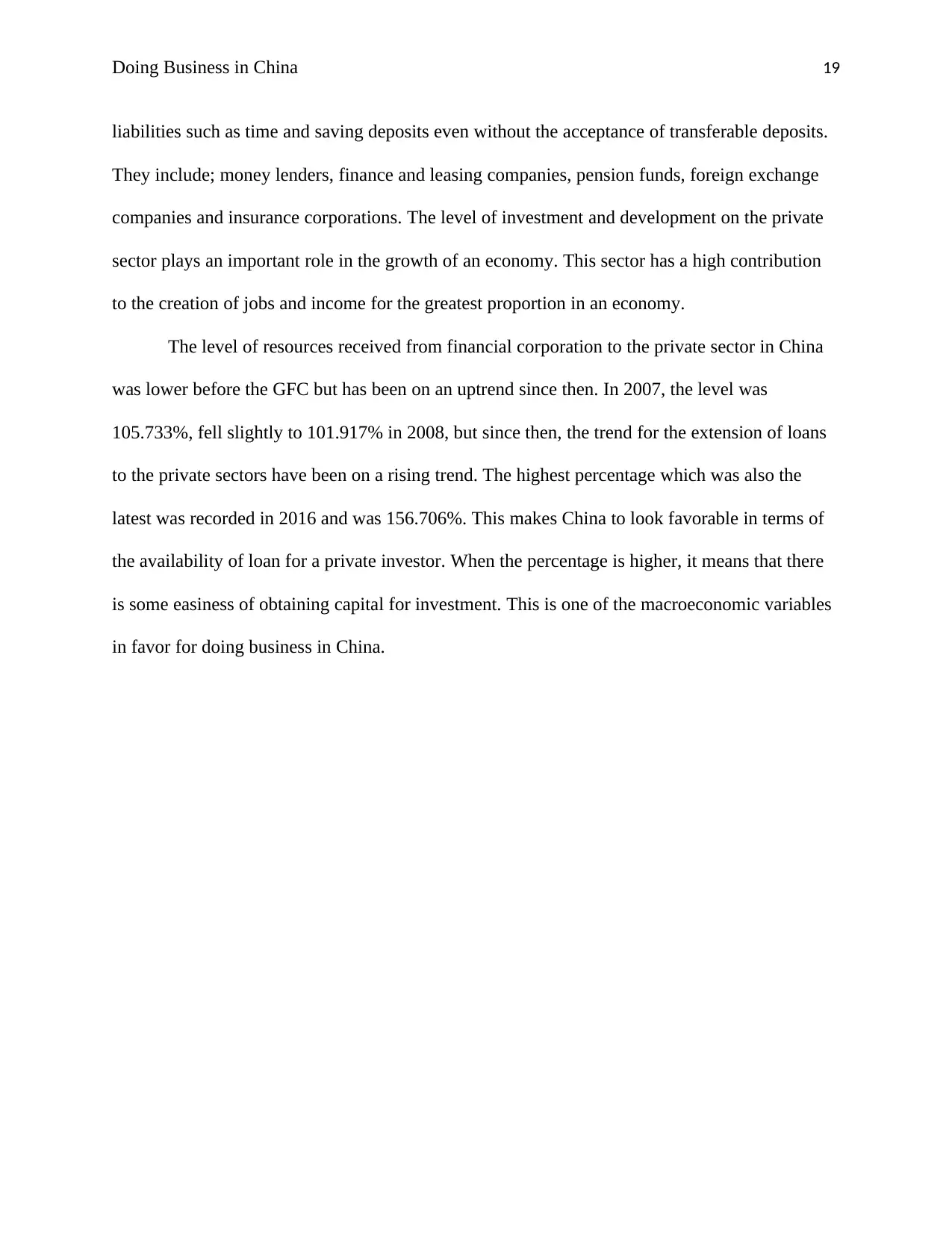
Doing Business in China 19
liabilities such as time and saving deposits even without the acceptance of transferable deposits.
They include; money lenders, finance and leasing companies, pension funds, foreign exchange
companies and insurance corporations. The level of investment and development on the private
sector plays an important role in the growth of an economy. This sector has a high contribution
to the creation of jobs and income for the greatest proportion in an economy.
The level of resources received from financial corporation to the private sector in China
was lower before the GFC but has been on an uptrend since then. In 2007, the level was
105.733%, fell slightly to 101.917% in 2008, but since then, the trend for the extension of loans
to the private sectors have been on a rising trend. The highest percentage which was also the
latest was recorded in 2016 and was 156.706%. This makes China to look favorable in terms of
the availability of loan for a private investor. When the percentage is higher, it means that there
is some easiness of obtaining capital for investment. This is one of the macroeconomic variables
in favor for doing business in China.
liabilities such as time and saving deposits even without the acceptance of transferable deposits.
They include; money lenders, finance and leasing companies, pension funds, foreign exchange
companies and insurance corporations. The level of investment and development on the private
sector plays an important role in the growth of an economy. This sector has a high contribution
to the creation of jobs and income for the greatest proportion in an economy.
The level of resources received from financial corporation to the private sector in China
was lower before the GFC but has been on an uptrend since then. In 2007, the level was
105.733%, fell slightly to 101.917% in 2008, but since then, the trend for the extension of loans
to the private sectors have been on a rising trend. The highest percentage which was also the
latest was recorded in 2016 and was 156.706%. This makes China to look favorable in terms of
the availability of loan for a private investor. When the percentage is higher, it means that there
is some easiness of obtaining capital for investment. This is one of the macroeconomic variables
in favor for doing business in China.
Paraphrase This Document
Need a fresh take? Get an instant paraphrase of this document with our AI Paraphraser
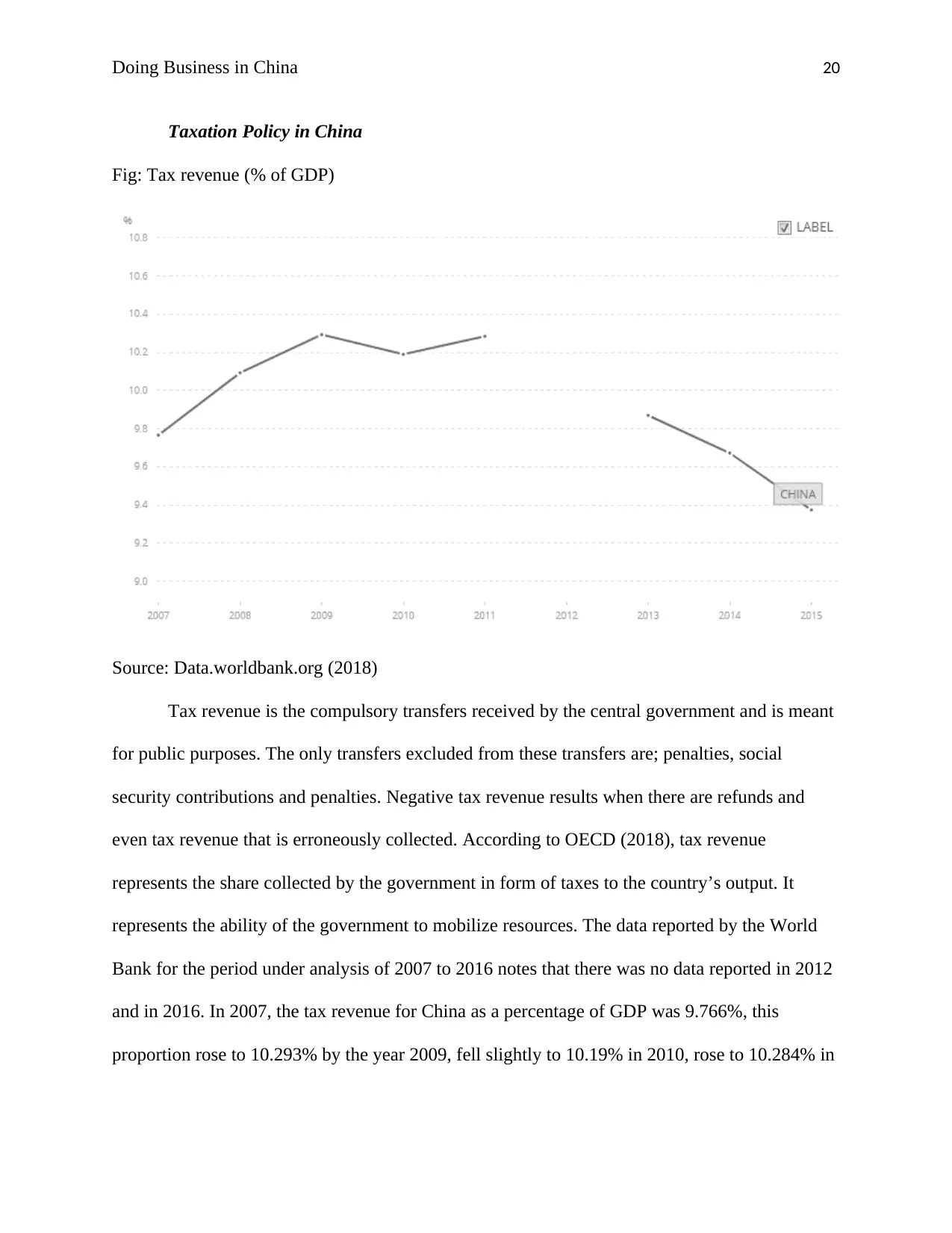
Doing Business in China 20
Taxation Policy in China
Fig: Tax revenue (% of GDP)
Source: Data.worldbank.org (2018)
Tax revenue is the compulsory transfers received by the central government and is meant
for public purposes. The only transfers excluded from these transfers are; penalties, social
security contributions and penalties. Negative tax revenue results when there are refunds and
even tax revenue that is erroneously collected. According to OECD (2018), tax revenue
represents the share collected by the government in form of taxes to the country’s output. It
represents the ability of the government to mobilize resources. The data reported by the World
Bank for the period under analysis of 2007 to 2016 notes that there was no data reported in 2012
and in 2016. In 2007, the tax revenue for China as a percentage of GDP was 9.766%, this
proportion rose to 10.293% by the year 2009, fell slightly to 10.19% in 2010, rose to 10.284% in
Taxation Policy in China
Fig: Tax revenue (% of GDP)
Source: Data.worldbank.org (2018)
Tax revenue is the compulsory transfers received by the central government and is meant
for public purposes. The only transfers excluded from these transfers are; penalties, social
security contributions and penalties. Negative tax revenue results when there are refunds and
even tax revenue that is erroneously collected. According to OECD (2018), tax revenue
represents the share collected by the government in form of taxes to the country’s output. It
represents the ability of the government to mobilize resources. The data reported by the World
Bank for the period under analysis of 2007 to 2016 notes that there was no data reported in 2012
and in 2016. In 2007, the tax revenue for China as a percentage of GDP was 9.766%, this
proportion rose to 10.293% by the year 2009, fell slightly to 10.19% in 2010, rose to 10.284% in
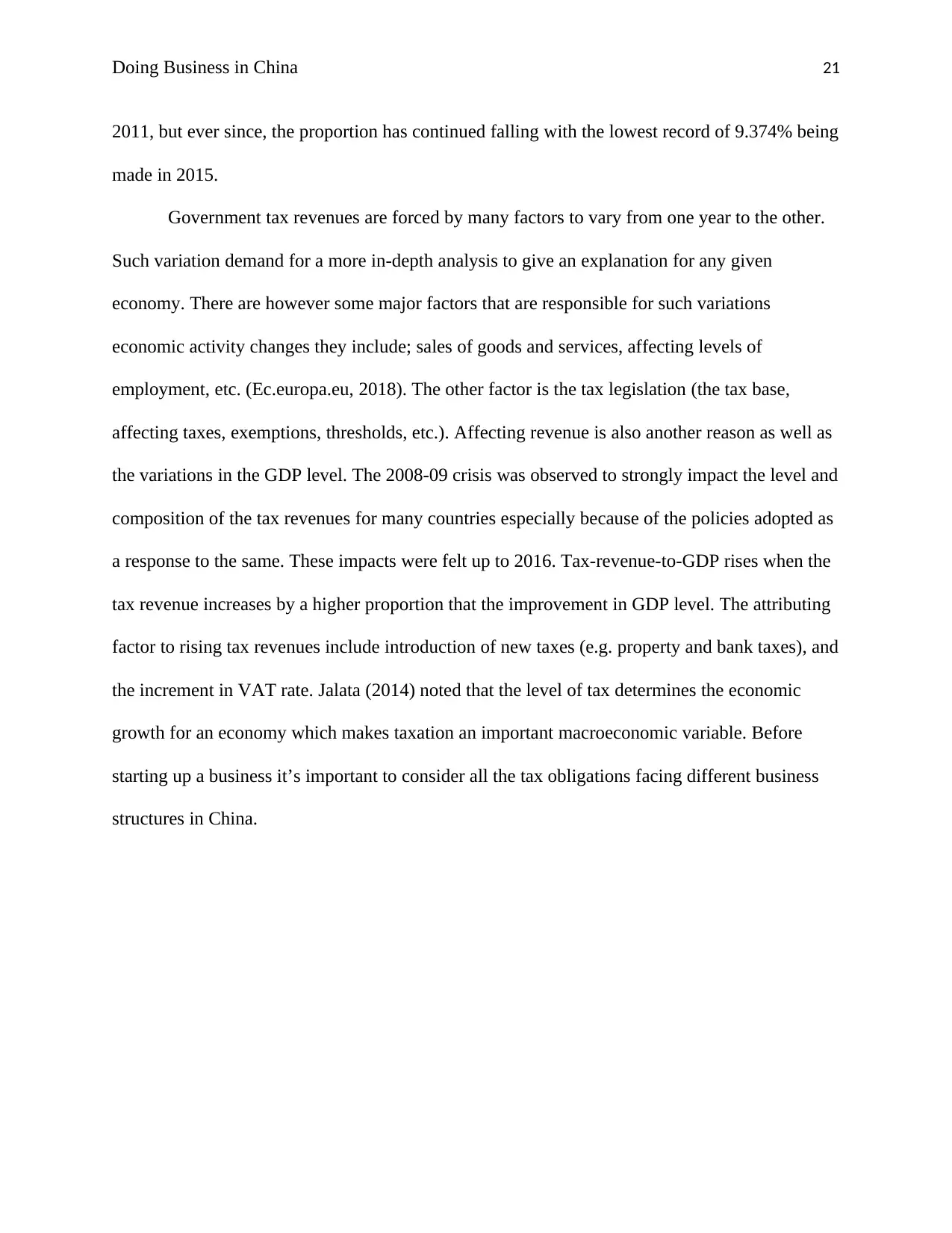
Doing Business in China 21
2011, but ever since, the proportion has continued falling with the lowest record of 9.374% being
made in 2015.
Government tax revenues are forced by many factors to vary from one year to the other.
Such variation demand for a more in-depth analysis to give an explanation for any given
economy. There are however some major factors that are responsible for such variations
economic activity changes they include; sales of goods and services, affecting levels of
employment, etc. (Ec.europa.eu, 2018). The other factor is the tax legislation (the tax base,
affecting taxes, exemptions, thresholds, etc.). Affecting revenue is also another reason as well as
the variations in the GDP level. The 2008-09 crisis was observed to strongly impact the level and
composition of the tax revenues for many countries especially because of the policies adopted as
a response to the same. These impacts were felt up to 2016. Tax-revenue-to-GDP rises when the
tax revenue increases by a higher proportion that the improvement in GDP level. The attributing
factor to rising tax revenues include introduction of new taxes (e.g. property and bank taxes), and
the increment in VAT rate. Jalata (2014) noted that the level of tax determines the economic
growth for an economy which makes taxation an important macroeconomic variable. Before
starting up a business it’s important to consider all the tax obligations facing different business
structures in China.
2011, but ever since, the proportion has continued falling with the lowest record of 9.374% being
made in 2015.
Government tax revenues are forced by many factors to vary from one year to the other.
Such variation demand for a more in-depth analysis to give an explanation for any given
economy. There are however some major factors that are responsible for such variations
economic activity changes they include; sales of goods and services, affecting levels of
employment, etc. (Ec.europa.eu, 2018). The other factor is the tax legislation (the tax base,
affecting taxes, exemptions, thresholds, etc.). Affecting revenue is also another reason as well as
the variations in the GDP level. The 2008-09 crisis was observed to strongly impact the level and
composition of the tax revenues for many countries especially because of the policies adopted as
a response to the same. These impacts were felt up to 2016. Tax-revenue-to-GDP rises when the
tax revenue increases by a higher proportion that the improvement in GDP level. The attributing
factor to rising tax revenues include introduction of new taxes (e.g. property and bank taxes), and
the increment in VAT rate. Jalata (2014) noted that the level of tax determines the economic
growth for an economy which makes taxation an important macroeconomic variable. Before
starting up a business it’s important to consider all the tax obligations facing different business
structures in China.
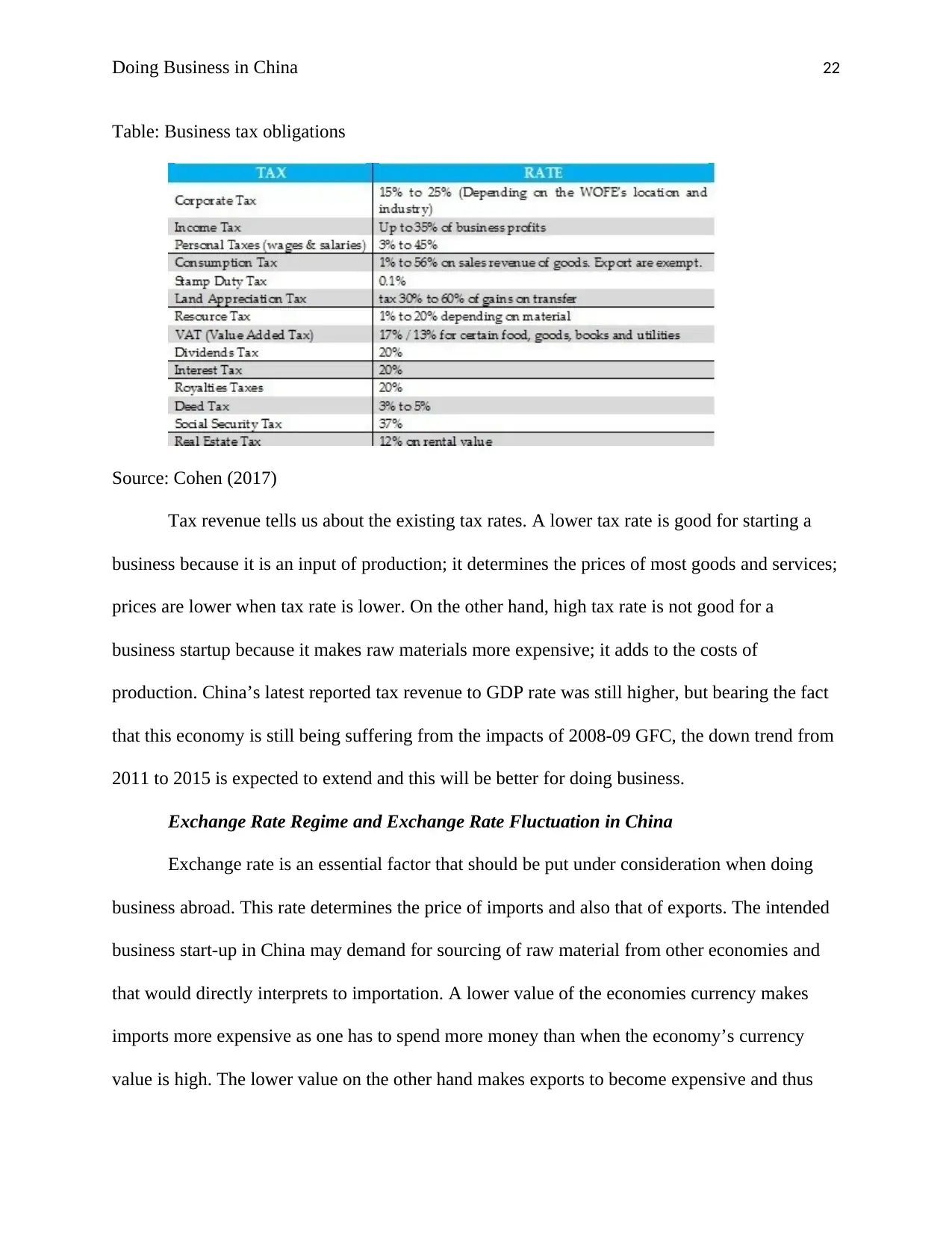
Doing Business in China 22
Table: Business tax obligations
Source: Cohen (2017)
Tax revenue tells us about the existing tax rates. A lower tax rate is good for starting a
business because it is an input of production; it determines the prices of most goods and services;
prices are lower when tax rate is lower. On the other hand, high tax rate is not good for a
business startup because it makes raw materials more expensive; it adds to the costs of
production. China’s latest reported tax revenue to GDP rate was still higher, but bearing the fact
that this economy is still being suffering from the impacts of 2008-09 GFC, the down trend from
2011 to 2015 is expected to extend and this will be better for doing business.
Exchange Rate Regime and Exchange Rate Fluctuation in China
Exchange rate is an essential factor that should be put under consideration when doing
business abroad. This rate determines the price of imports and also that of exports. The intended
business start-up in China may demand for sourcing of raw material from other economies and
that would directly interprets to importation. A lower value of the economies currency makes
imports more expensive as one has to spend more money than when the economy’s currency
value is high. The lower value on the other hand makes exports to become expensive and thus
Table: Business tax obligations
Source: Cohen (2017)
Tax revenue tells us about the existing tax rates. A lower tax rate is good for starting a
business because it is an input of production; it determines the prices of most goods and services;
prices are lower when tax rate is lower. On the other hand, high tax rate is not good for a
business startup because it makes raw materials more expensive; it adds to the costs of
production. China’s latest reported tax revenue to GDP rate was still higher, but bearing the fact
that this economy is still being suffering from the impacts of 2008-09 GFC, the down trend from
2011 to 2015 is expected to extend and this will be better for doing business.
Exchange Rate Regime and Exchange Rate Fluctuation in China
Exchange rate is an essential factor that should be put under consideration when doing
business abroad. This rate determines the price of imports and also that of exports. The intended
business start-up in China may demand for sourcing of raw material from other economies and
that would directly interprets to importation. A lower value of the economies currency makes
imports more expensive as one has to spend more money than when the economy’s currency
value is high. The lower value on the other hand makes exports to become expensive and thus
Secure Best Marks with AI Grader
Need help grading? Try our AI Grader for instant feedback on your assignments.
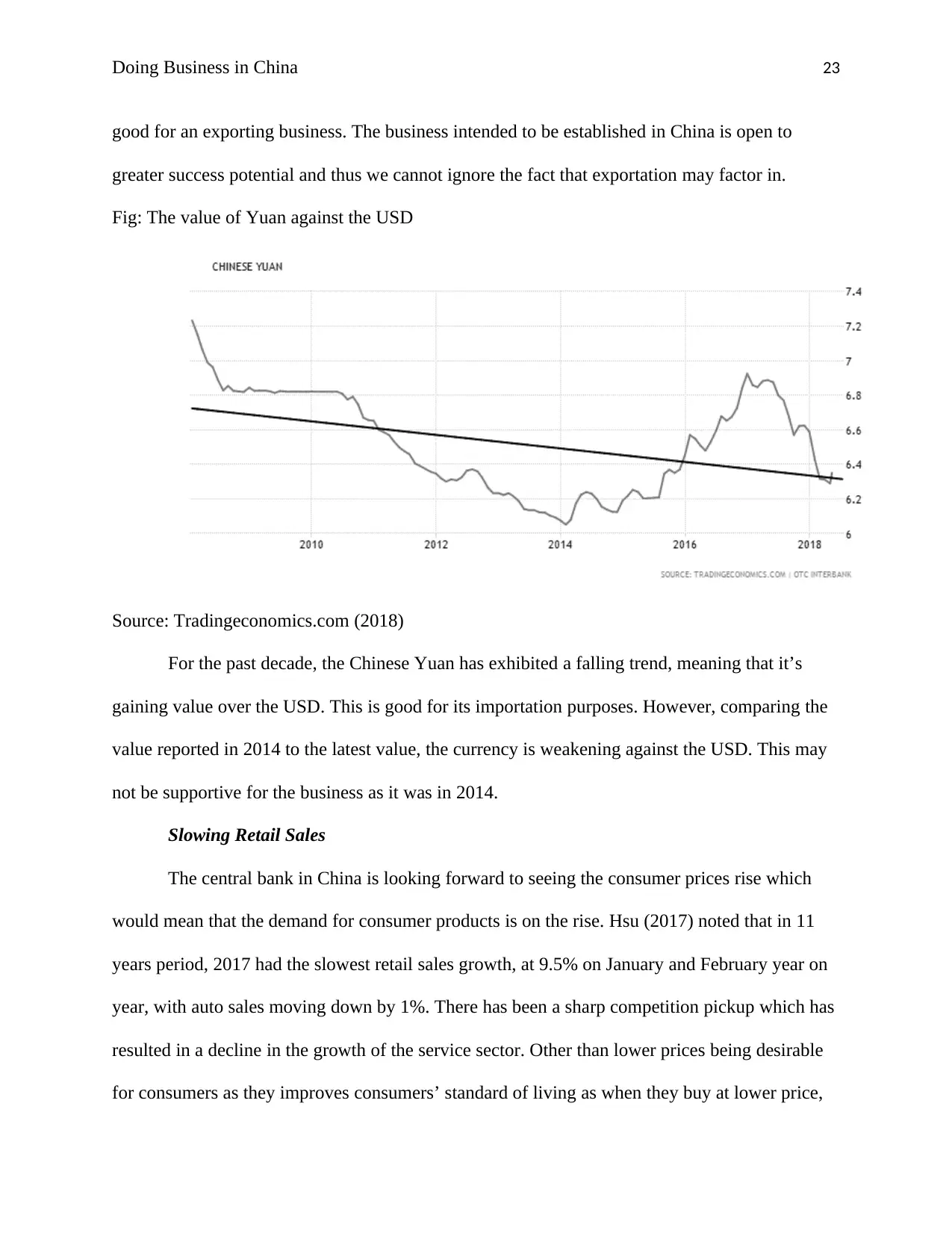
Doing Business in China 23
good for an exporting business. The business intended to be established in China is open to
greater success potential and thus we cannot ignore the fact that exportation may factor in.
Fig: The value of Yuan against the USD
Source: Tradingeconomics.com (2018)
For the past decade, the Chinese Yuan has exhibited a falling trend, meaning that it’s
gaining value over the USD. This is good for its importation purposes. However, comparing the
value reported in 2014 to the latest value, the currency is weakening against the USD. This may
not be supportive for the business as it was in 2014.
Slowing Retail Sales
The central bank in China is looking forward to seeing the consumer prices rise which
would mean that the demand for consumer products is on the rise. Hsu (2017) noted that in 11
years period, 2017 had the slowest retail sales growth, at 9.5% on January and February year on
year, with auto sales moving down by 1%. There has been a sharp competition pickup which has
resulted in a decline in the growth of the service sector. Other than lower prices being desirable
for consumers as they improves consumers’ standard of living as when they buy at lower price,
good for an exporting business. The business intended to be established in China is open to
greater success potential and thus we cannot ignore the fact that exportation may factor in.
Fig: The value of Yuan against the USD
Source: Tradingeconomics.com (2018)
For the past decade, the Chinese Yuan has exhibited a falling trend, meaning that it’s
gaining value over the USD. This is good for its importation purposes. However, comparing the
value reported in 2014 to the latest value, the currency is weakening against the USD. This may
not be supportive for the business as it was in 2014.
Slowing Retail Sales
The central bank in China is looking forward to seeing the consumer prices rise which
would mean that the demand for consumer products is on the rise. Hsu (2017) noted that in 11
years period, 2017 had the slowest retail sales growth, at 9.5% on January and February year on
year, with auto sales moving down by 1%. There has been a sharp competition pickup which has
resulted in a decline in the growth of the service sector. Other than lower prices being desirable
for consumers as they improves consumers’ standard of living as when they buy at lower price,

Doing Business in China 24
they are left with more disposable income to be used in demanding other goods, it raises other
concerns. Lower prices are mostly encouraged by the promotion of competition in an economy.
Some of the concerns raised by low prices include; the failure of income growth to keep up with
the growth in consumption. The retail spending will be dragged down until there will be a rise in
the pay made to the workers. For a consumer to be included in the middle class classification,
there is minimum income condition of $12,000, but the average GDP per capital reported yearly
has remained below $8,000.
In order to maintain economic stability and self-sustaining growth, the government of
China has actively been encouraging domestic consumption. This move is meant to accompany a
significant structural change from China being manufacturing based to service based; the
purchase for domestic produced goods and services is expected to be stronger (Hsu, 2017).
However, there has been a sluggish shift to the service based economy to facilitate this major
transformation despite the growth in competition. China is facing challenges in stimulating the
aggregate demand. Demand is an important factor to be considered before starting a business. An
investor need to estimate his/her sales revenue in order to determine whether the business will be
profitable or not. At the current level of low demand in China, investment will not be expected to
pick up as demand deficiency brings down businesses.
Two Monetary Policies in China
In late October 2017, People’s Bank of China’s (PBoC’s) for the first time injected 63-
day funding into the economy’s financial system (Bloomberg.com, 2017). This reassured lenders
of an increase in the availability of funding. Zhao (2017) noted that earlier in 2017, the PBoC
hiked its interest rate and tightened the money supply as well. This move was meant to stem the
they are left with more disposable income to be used in demanding other goods, it raises other
concerns. Lower prices are mostly encouraged by the promotion of competition in an economy.
Some of the concerns raised by low prices include; the failure of income growth to keep up with
the growth in consumption. The retail spending will be dragged down until there will be a rise in
the pay made to the workers. For a consumer to be included in the middle class classification,
there is minimum income condition of $12,000, but the average GDP per capital reported yearly
has remained below $8,000.
In order to maintain economic stability and self-sustaining growth, the government of
China has actively been encouraging domestic consumption. This move is meant to accompany a
significant structural change from China being manufacturing based to service based; the
purchase for domestic produced goods and services is expected to be stronger (Hsu, 2017).
However, there has been a sluggish shift to the service based economy to facilitate this major
transformation despite the growth in competition. China is facing challenges in stimulating the
aggregate demand. Demand is an important factor to be considered before starting a business. An
investor need to estimate his/her sales revenue in order to determine whether the business will be
profitable or not. At the current level of low demand in China, investment will not be expected to
pick up as demand deficiency brings down businesses.
Two Monetary Policies in China
In late October 2017, People’s Bank of China’s (PBoC’s) for the first time injected 63-
day funding into the economy’s financial system (Bloomberg.com, 2017). This reassured lenders
of an increase in the availability of funding. Zhao (2017) noted that earlier in 2017, the PBoC
hiked its interest rate and tightened the money supply as well. This move was meant to stem the
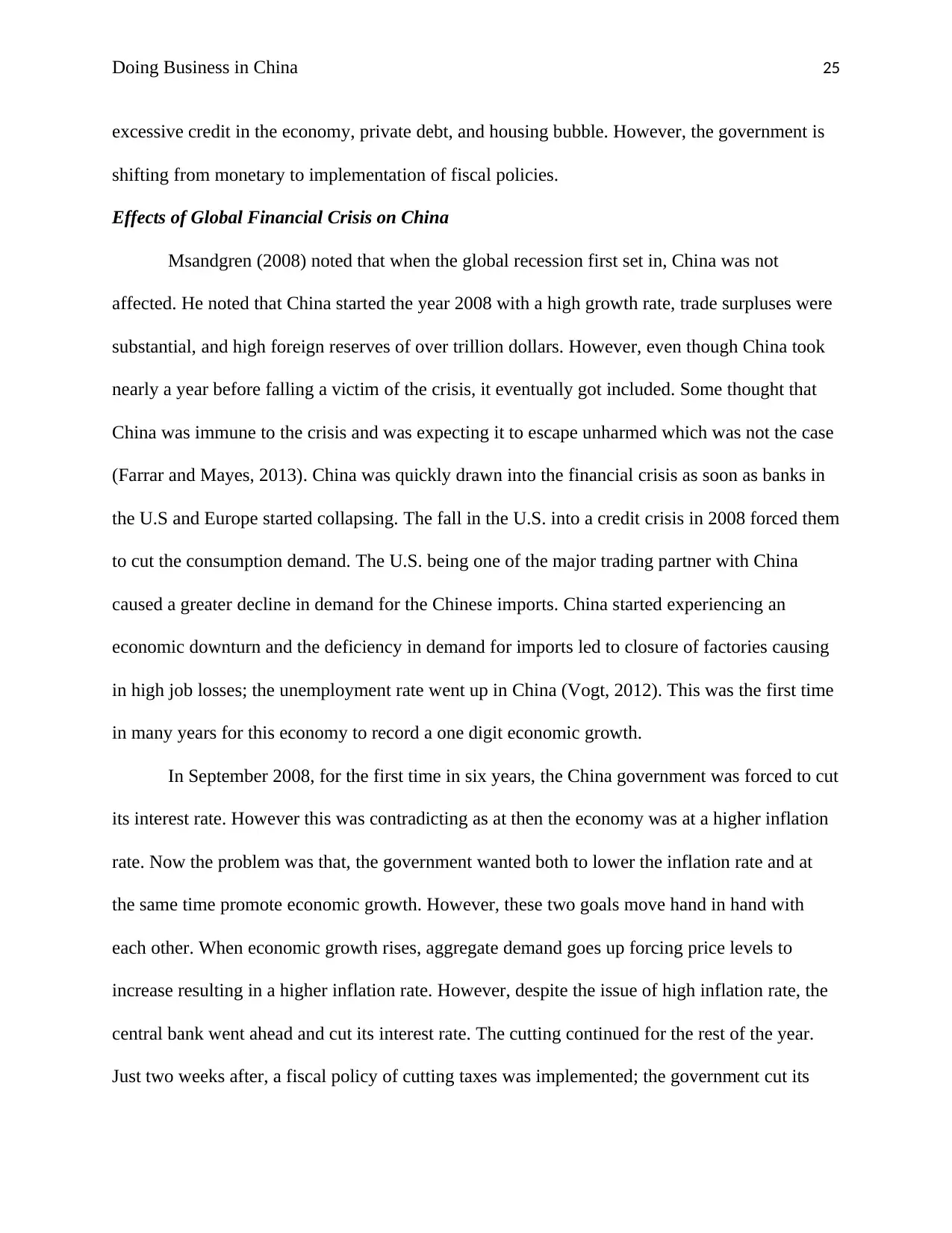
Doing Business in China 25
excessive credit in the economy, private debt, and housing bubble. However, the government is
shifting from monetary to implementation of fiscal policies.
Effects of Global Financial Crisis on China
Msandgren (2008) noted that when the global recession first set in, China was not
affected. He noted that China started the year 2008 with a high growth rate, trade surpluses were
substantial, and high foreign reserves of over trillion dollars. However, even though China took
nearly a year before falling a victim of the crisis, it eventually got included. Some thought that
China was immune to the crisis and was expecting it to escape unharmed which was not the case
(Farrar and Mayes, 2013). China was quickly drawn into the financial crisis as soon as banks in
the U.S and Europe started collapsing. The fall in the U.S. into a credit crisis in 2008 forced them
to cut the consumption demand. The U.S. being one of the major trading partner with China
caused a greater decline in demand for the Chinese imports. China started experiencing an
economic downturn and the deficiency in demand for imports led to closure of factories causing
in high job losses; the unemployment rate went up in China (Vogt, 2012). This was the first time
in many years for this economy to record a one digit economic growth.
In September 2008, for the first time in six years, the China government was forced to cut
its interest rate. However this was contradicting as at then the economy was at a higher inflation
rate. Now the problem was that, the government wanted both to lower the inflation rate and at
the same time promote economic growth. However, these two goals move hand in hand with
each other. When economic growth rises, aggregate demand goes up forcing price levels to
increase resulting in a higher inflation rate. However, despite the issue of high inflation rate, the
central bank went ahead and cut its interest rate. The cutting continued for the rest of the year.
Just two weeks after, a fiscal policy of cutting taxes was implemented; the government cut its
excessive credit in the economy, private debt, and housing bubble. However, the government is
shifting from monetary to implementation of fiscal policies.
Effects of Global Financial Crisis on China
Msandgren (2008) noted that when the global recession first set in, China was not
affected. He noted that China started the year 2008 with a high growth rate, trade surpluses were
substantial, and high foreign reserves of over trillion dollars. However, even though China took
nearly a year before falling a victim of the crisis, it eventually got included. Some thought that
China was immune to the crisis and was expecting it to escape unharmed which was not the case
(Farrar and Mayes, 2013). China was quickly drawn into the financial crisis as soon as banks in
the U.S and Europe started collapsing. The fall in the U.S. into a credit crisis in 2008 forced them
to cut the consumption demand. The U.S. being one of the major trading partner with China
caused a greater decline in demand for the Chinese imports. China started experiencing an
economic downturn and the deficiency in demand for imports led to closure of factories causing
in high job losses; the unemployment rate went up in China (Vogt, 2012). This was the first time
in many years for this economy to record a one digit economic growth.
In September 2008, for the first time in six years, the China government was forced to cut
its interest rate. However this was contradicting as at then the economy was at a higher inflation
rate. Now the problem was that, the government wanted both to lower the inflation rate and at
the same time promote economic growth. However, these two goals move hand in hand with
each other. When economic growth rises, aggregate demand goes up forcing price levels to
increase resulting in a higher inflation rate. However, despite the issue of high inflation rate, the
central bank went ahead and cut its interest rate. The cutting continued for the rest of the year.
Just two weeks after, a fiscal policy of cutting taxes was implemented; the government cut its
Paraphrase This Document
Need a fresh take? Get an instant paraphrase of this document with our AI Paraphraser
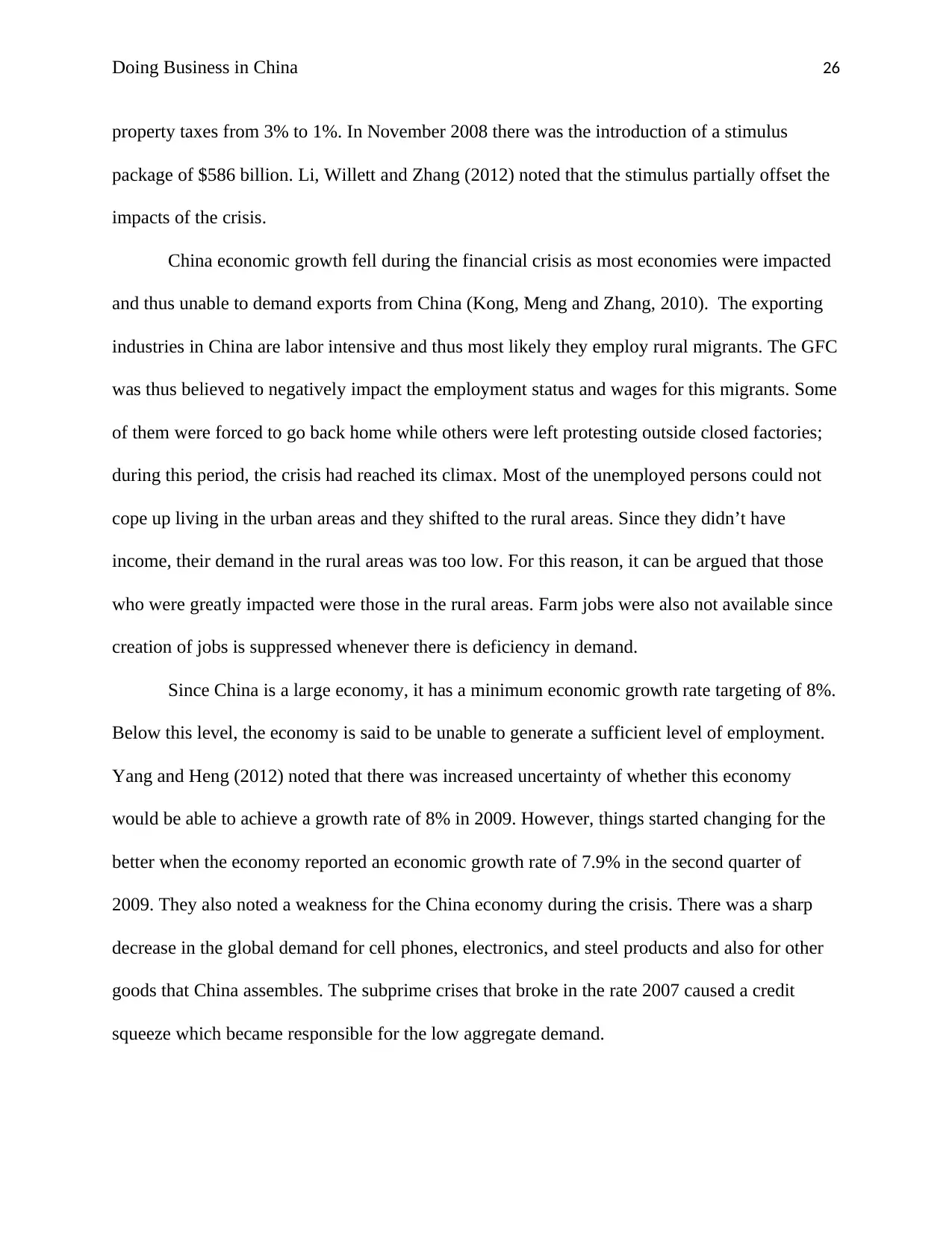
Doing Business in China 26
property taxes from 3% to 1%. In November 2008 there was the introduction of a stimulus
package of $586 billion. Li, Willett and Zhang (2012) noted that the stimulus partially offset the
impacts of the crisis.
China economic growth fell during the financial crisis as most economies were impacted
and thus unable to demand exports from China (Kong, Meng and Zhang, 2010). The exporting
industries in China are labor intensive and thus most likely they employ rural migrants. The GFC
was thus believed to negatively impact the employment status and wages for this migrants. Some
of them were forced to go back home while others were left protesting outside closed factories;
during this period, the crisis had reached its climax. Most of the unemployed persons could not
cope up living in the urban areas and they shifted to the rural areas. Since they didn’t have
income, their demand in the rural areas was too low. For this reason, it can be argued that those
who were greatly impacted were those in the rural areas. Farm jobs were also not available since
creation of jobs is suppressed whenever there is deficiency in demand.
Since China is a large economy, it has a minimum economic growth rate targeting of 8%.
Below this level, the economy is said to be unable to generate a sufficient level of employment.
Yang and Heng (2012) noted that there was increased uncertainty of whether this economy
would be able to achieve a growth rate of 8% in 2009. However, things started changing for the
better when the economy reported an economic growth rate of 7.9% in the second quarter of
2009. They also noted a weakness for the China economy during the crisis. There was a sharp
decrease in the global demand for cell phones, electronics, and steel products and also for other
goods that China assembles. The subprime crises that broke in the rate 2007 caused a credit
squeeze which became responsible for the low aggregate demand.
property taxes from 3% to 1%. In November 2008 there was the introduction of a stimulus
package of $586 billion. Li, Willett and Zhang (2012) noted that the stimulus partially offset the
impacts of the crisis.
China economic growth fell during the financial crisis as most economies were impacted
and thus unable to demand exports from China (Kong, Meng and Zhang, 2010). The exporting
industries in China are labor intensive and thus most likely they employ rural migrants. The GFC
was thus believed to negatively impact the employment status and wages for this migrants. Some
of them were forced to go back home while others were left protesting outside closed factories;
during this period, the crisis had reached its climax. Most of the unemployed persons could not
cope up living in the urban areas and they shifted to the rural areas. Since they didn’t have
income, their demand in the rural areas was too low. For this reason, it can be argued that those
who were greatly impacted were those in the rural areas. Farm jobs were also not available since
creation of jobs is suppressed whenever there is deficiency in demand.
Since China is a large economy, it has a minimum economic growth rate targeting of 8%.
Below this level, the economy is said to be unable to generate a sufficient level of employment.
Yang and Heng (2012) noted that there was increased uncertainty of whether this economy
would be able to achieve a growth rate of 8% in 2009. However, things started changing for the
better when the economy reported an economic growth rate of 7.9% in the second quarter of
2009. They also noted a weakness for the China economy during the crisis. There was a sharp
decrease in the global demand for cell phones, electronics, and steel products and also for other
goods that China assembles. The subprime crises that broke in the rate 2007 caused a credit
squeeze which became responsible for the low aggregate demand.
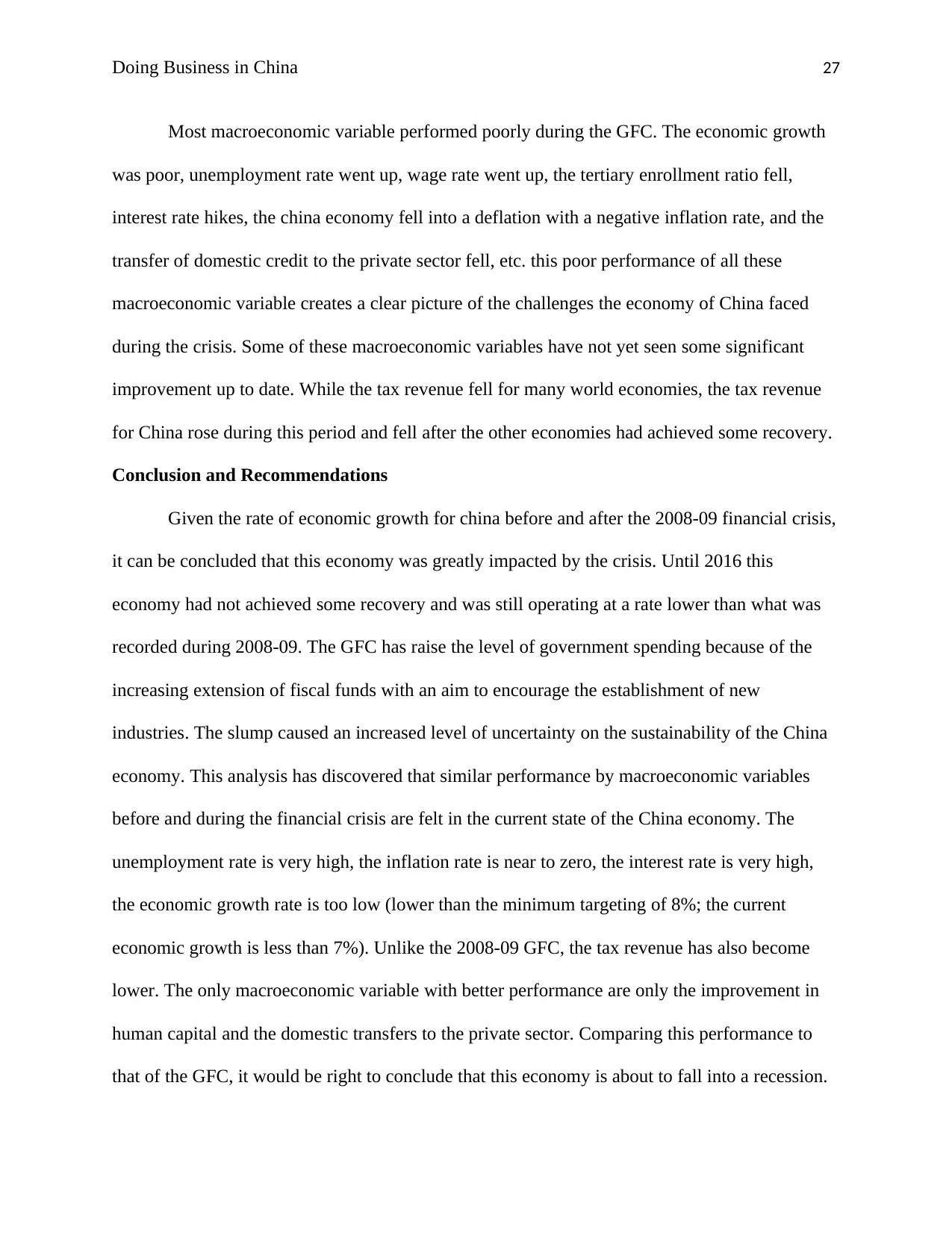
Doing Business in China 27
Most macroeconomic variable performed poorly during the GFC. The economic growth
was poor, unemployment rate went up, wage rate went up, the tertiary enrollment ratio fell,
interest rate hikes, the china economy fell into a deflation with a negative inflation rate, and the
transfer of domestic credit to the private sector fell, etc. this poor performance of all these
macroeconomic variable creates a clear picture of the challenges the economy of China faced
during the crisis. Some of these macroeconomic variables have not yet seen some significant
improvement up to date. While the tax revenue fell for many world economies, the tax revenue
for China rose during this period and fell after the other economies had achieved some recovery.
Conclusion and Recommendations
Given the rate of economic growth for china before and after the 2008-09 financial crisis,
it can be concluded that this economy was greatly impacted by the crisis. Until 2016 this
economy had not achieved some recovery and was still operating at a rate lower than what was
recorded during 2008-09. The GFC has raise the level of government spending because of the
increasing extension of fiscal funds with an aim to encourage the establishment of new
industries. The slump caused an increased level of uncertainty on the sustainability of the China
economy. This analysis has discovered that similar performance by macroeconomic variables
before and during the financial crisis are felt in the current state of the China economy. The
unemployment rate is very high, the inflation rate is near to zero, the interest rate is very high,
the economic growth rate is too low (lower than the minimum targeting of 8%; the current
economic growth is less than 7%). Unlike the 2008-09 GFC, the tax revenue has also become
lower. The only macroeconomic variable with better performance are only the improvement in
human capital and the domestic transfers to the private sector. Comparing this performance to
that of the GFC, it would be right to conclude that this economy is about to fall into a recession.
Most macroeconomic variable performed poorly during the GFC. The economic growth
was poor, unemployment rate went up, wage rate went up, the tertiary enrollment ratio fell,
interest rate hikes, the china economy fell into a deflation with a negative inflation rate, and the
transfer of domestic credit to the private sector fell, etc. this poor performance of all these
macroeconomic variable creates a clear picture of the challenges the economy of China faced
during the crisis. Some of these macroeconomic variables have not yet seen some significant
improvement up to date. While the tax revenue fell for many world economies, the tax revenue
for China rose during this period and fell after the other economies had achieved some recovery.
Conclusion and Recommendations
Given the rate of economic growth for china before and after the 2008-09 financial crisis,
it can be concluded that this economy was greatly impacted by the crisis. Until 2016 this
economy had not achieved some recovery and was still operating at a rate lower than what was
recorded during 2008-09. The GFC has raise the level of government spending because of the
increasing extension of fiscal funds with an aim to encourage the establishment of new
industries. The slump caused an increased level of uncertainty on the sustainability of the China
economy. This analysis has discovered that similar performance by macroeconomic variables
before and during the financial crisis are felt in the current state of the China economy. The
unemployment rate is very high, the inflation rate is near to zero, the interest rate is very high,
the economic growth rate is too low (lower than the minimum targeting of 8%; the current
economic growth is less than 7%). Unlike the 2008-09 GFC, the tax revenue has also become
lower. The only macroeconomic variable with better performance are only the improvement in
human capital and the domestic transfers to the private sector. Comparing this performance to
that of the GFC, it would be right to conclude that this economy is about to fall into a recession.
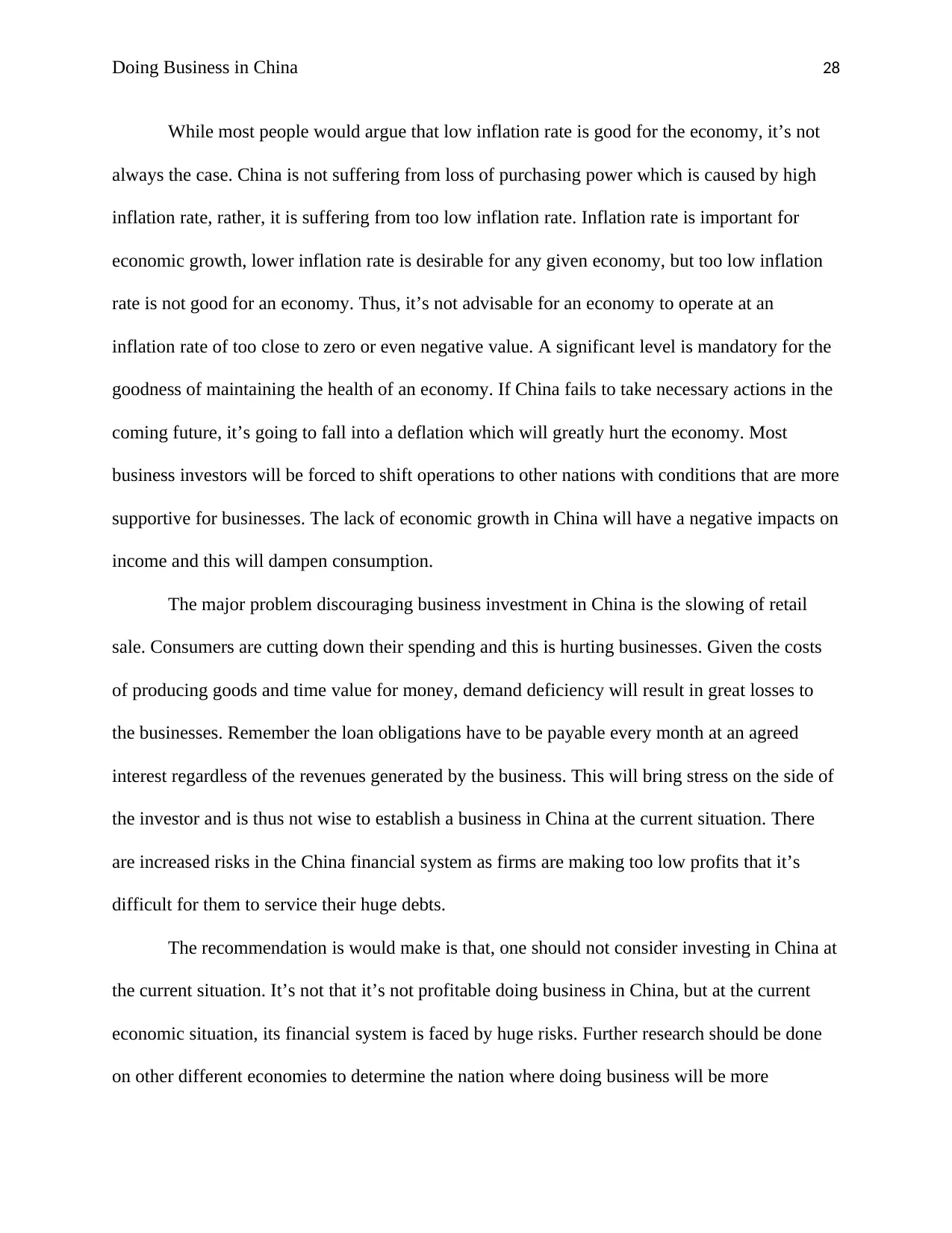
Doing Business in China 28
While most people would argue that low inflation rate is good for the economy, it’s not
always the case. China is not suffering from loss of purchasing power which is caused by high
inflation rate, rather, it is suffering from too low inflation rate. Inflation rate is important for
economic growth, lower inflation rate is desirable for any given economy, but too low inflation
rate is not good for an economy. Thus, it’s not advisable for an economy to operate at an
inflation rate of too close to zero or even negative value. A significant level is mandatory for the
goodness of maintaining the health of an economy. If China fails to take necessary actions in the
coming future, it’s going to fall into a deflation which will greatly hurt the economy. Most
business investors will be forced to shift operations to other nations with conditions that are more
supportive for businesses. The lack of economic growth in China will have a negative impacts on
income and this will dampen consumption.
The major problem discouraging business investment in China is the slowing of retail
sale. Consumers are cutting down their spending and this is hurting businesses. Given the costs
of producing goods and time value for money, demand deficiency will result in great losses to
the businesses. Remember the loan obligations have to be payable every month at an agreed
interest regardless of the revenues generated by the business. This will bring stress on the side of
the investor and is thus not wise to establish a business in China at the current situation. There
are increased risks in the China financial system as firms are making too low profits that it’s
difficult for them to service their huge debts.
The recommendation is would make is that, one should not consider investing in China at
the current situation. It’s not that it’s not profitable doing business in China, but at the current
economic situation, its financial system is faced by huge risks. Further research should be done
on other different economies to determine the nation where doing business will be more
While most people would argue that low inflation rate is good for the economy, it’s not
always the case. China is not suffering from loss of purchasing power which is caused by high
inflation rate, rather, it is suffering from too low inflation rate. Inflation rate is important for
economic growth, lower inflation rate is desirable for any given economy, but too low inflation
rate is not good for an economy. Thus, it’s not advisable for an economy to operate at an
inflation rate of too close to zero or even negative value. A significant level is mandatory for the
goodness of maintaining the health of an economy. If China fails to take necessary actions in the
coming future, it’s going to fall into a deflation which will greatly hurt the economy. Most
business investors will be forced to shift operations to other nations with conditions that are more
supportive for businesses. The lack of economic growth in China will have a negative impacts on
income and this will dampen consumption.
The major problem discouraging business investment in China is the slowing of retail
sale. Consumers are cutting down their spending and this is hurting businesses. Given the costs
of producing goods and time value for money, demand deficiency will result in great losses to
the businesses. Remember the loan obligations have to be payable every month at an agreed
interest regardless of the revenues generated by the business. This will bring stress on the side of
the investor and is thus not wise to establish a business in China at the current situation. There
are increased risks in the China financial system as firms are making too low profits that it’s
difficult for them to service their huge debts.
The recommendation is would make is that, one should not consider investing in China at
the current situation. It’s not that it’s not profitable doing business in China, but at the current
economic situation, its financial system is faced by huge risks. Further research should be done
on other different economies to determine the nation where doing business will be more
Secure Best Marks with AI Grader
Need help grading? Try our AI Grader for instant feedback on your assignments.
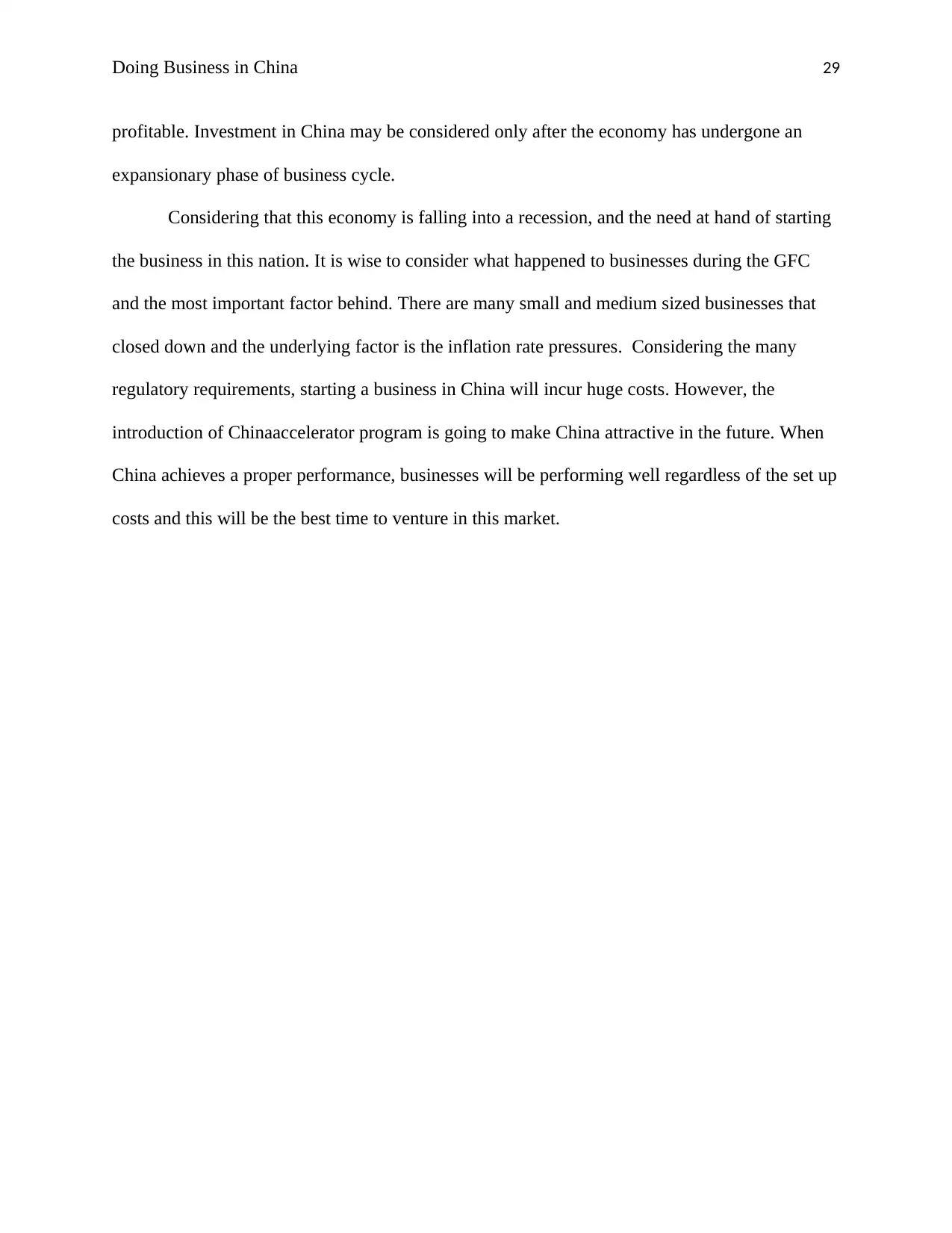
Doing Business in China 29
profitable. Investment in China may be considered only after the economy has undergone an
expansionary phase of business cycle.
Considering that this economy is falling into a recession, and the need at hand of starting
the business in this nation. It is wise to consider what happened to businesses during the GFC
and the most important factor behind. There are many small and medium sized businesses that
closed down and the underlying factor is the inflation rate pressures. Considering the many
regulatory requirements, starting a business in China will incur huge costs. However, the
introduction of Chinaaccelerator program is going to make China attractive in the future. When
China achieves a proper performance, businesses will be performing well regardless of the set up
costs and this will be the best time to venture in this market.
profitable. Investment in China may be considered only after the economy has undergone an
expansionary phase of business cycle.
Considering that this economy is falling into a recession, and the need at hand of starting
the business in this nation. It is wise to consider what happened to businesses during the GFC
and the most important factor behind. There are many small and medium sized businesses that
closed down and the underlying factor is the inflation rate pressures. Considering the many
regulatory requirements, starting a business in China will incur huge costs. However, the
introduction of Chinaaccelerator program is going to make China attractive in the future. When
China achieves a proper performance, businesses will be performing well regardless of the set up
costs and this will be the best time to venture in this market.
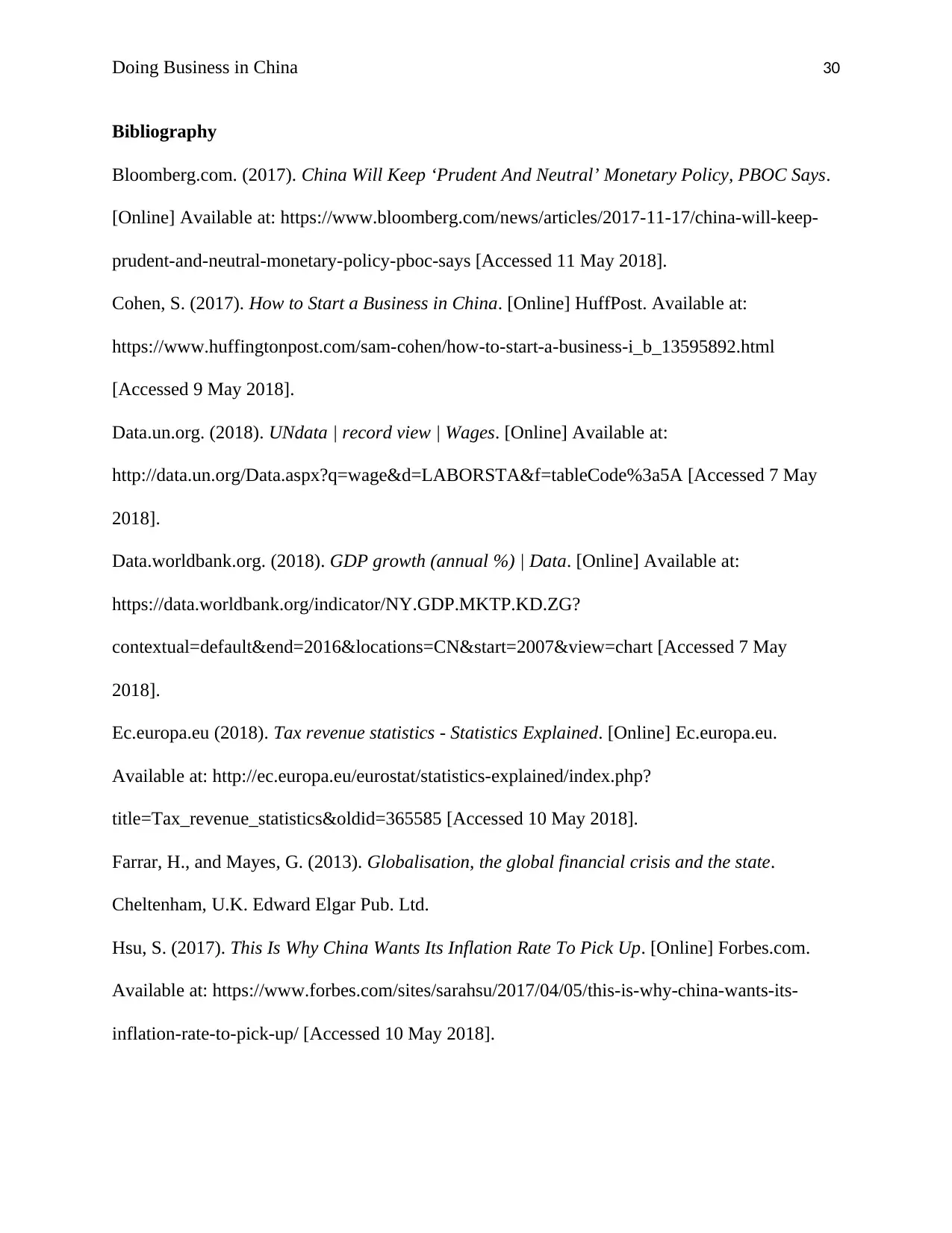
Doing Business in China 30
Bibliography
Bloomberg.com. (2017). China Will Keep ‘Prudent And Neutral’ Monetary Policy, PBOC Says.
[Online] Available at: https://www.bloomberg.com/news/articles/2017-11-17/china-will-keep-
prudent-and-neutral-monetary-policy-pboc-says [Accessed 11 May 2018].
Cohen, S. (2017). How to Start a Business in China. [Online] HuffPost. Available at:
https://www.huffingtonpost.com/sam-cohen/how-to-start-a-business-i_b_13595892.html
[Accessed 9 May 2018].
Data.un.org. (2018). UNdata | record view | Wages. [Online] Available at:
http://data.un.org/Data.aspx?q=wage&d=LABORSTA&f=tableCode%3a5A [Accessed 7 May
2018].
Data.worldbank.org. (2018). GDP growth (annual %) | Data. [Online] Available at:
https://data.worldbank.org/indicator/NY.GDP.MKTP.KD.ZG?
contextual=default&end=2016&locations=CN&start=2007&view=chart [Accessed 7 May
2018].
Ec.europa.eu (2018). Tax revenue statistics - Statistics Explained. [Online] Ec.europa.eu.
Available at: http://ec.europa.eu/eurostat/statistics-explained/index.php?
title=Tax_revenue_statistics&oldid=365585 [Accessed 10 May 2018].
Farrar, H., and Mayes, G. (2013). Globalisation, the global financial crisis and the state.
Cheltenham, U.K. Edward Elgar Pub. Ltd.
Hsu, S. (2017). This Is Why China Wants Its Inflation Rate To Pick Up. [Online] Forbes.com.
Available at: https://www.forbes.com/sites/sarahsu/2017/04/05/this-is-why-china-wants-its-
inflation-rate-to-pick-up/ [Accessed 10 May 2018].
Bibliography
Bloomberg.com. (2017). China Will Keep ‘Prudent And Neutral’ Monetary Policy, PBOC Says.
[Online] Available at: https://www.bloomberg.com/news/articles/2017-11-17/china-will-keep-
prudent-and-neutral-monetary-policy-pboc-says [Accessed 11 May 2018].
Cohen, S. (2017). How to Start a Business in China. [Online] HuffPost. Available at:
https://www.huffingtonpost.com/sam-cohen/how-to-start-a-business-i_b_13595892.html
[Accessed 9 May 2018].
Data.un.org. (2018). UNdata | record view | Wages. [Online] Available at:
http://data.un.org/Data.aspx?q=wage&d=LABORSTA&f=tableCode%3a5A [Accessed 7 May
2018].
Data.worldbank.org. (2018). GDP growth (annual %) | Data. [Online] Available at:
https://data.worldbank.org/indicator/NY.GDP.MKTP.KD.ZG?
contextual=default&end=2016&locations=CN&start=2007&view=chart [Accessed 7 May
2018].
Ec.europa.eu (2018). Tax revenue statistics - Statistics Explained. [Online] Ec.europa.eu.
Available at: http://ec.europa.eu/eurostat/statistics-explained/index.php?
title=Tax_revenue_statistics&oldid=365585 [Accessed 10 May 2018].
Farrar, H., and Mayes, G. (2013). Globalisation, the global financial crisis and the state.
Cheltenham, U.K. Edward Elgar Pub. Ltd.
Hsu, S. (2017). This Is Why China Wants Its Inflation Rate To Pick Up. [Online] Forbes.com.
Available at: https://www.forbes.com/sites/sarahsu/2017/04/05/this-is-why-china-wants-its-
inflation-rate-to-pick-up/ [Accessed 10 May 2018].
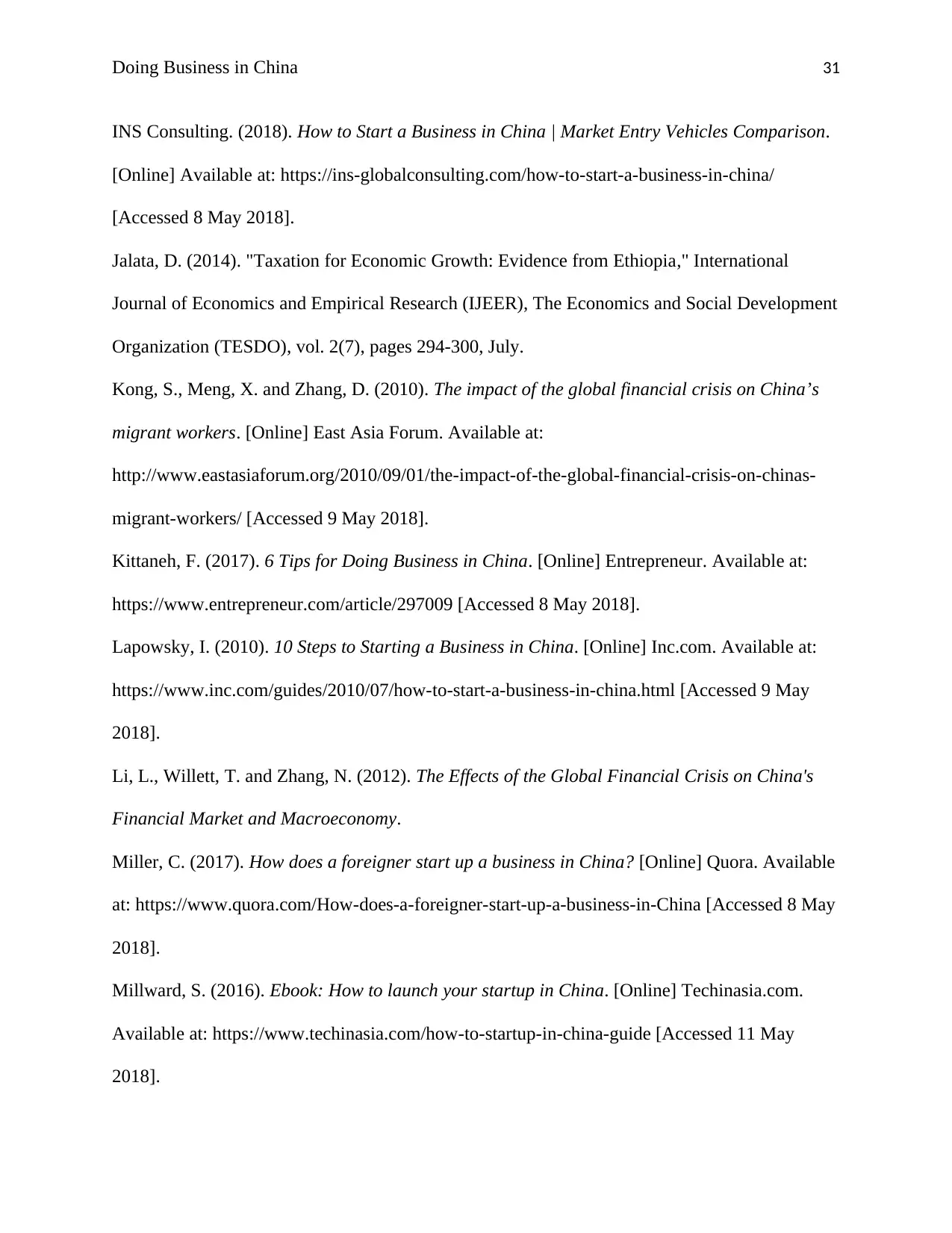
Doing Business in China 31
INS Consulting. (2018). How to Start a Business in China | Market Entry Vehicles Comparison.
[Online] Available at: https://ins-globalconsulting.com/how-to-start-a-business-in-china/
[Accessed 8 May 2018].
Jalata, D. (2014). "Taxation for Economic Growth: Evidence from Ethiopia," International
Journal of Economics and Empirical Research (IJEER), The Economics and Social Development
Organization (TESDO), vol. 2(7), pages 294-300, July.
Kong, S., Meng, X. and Zhang, D. (2010). The impact of the global financial crisis on China’s
migrant workers. [Online] East Asia Forum. Available at:
http://www.eastasiaforum.org/2010/09/01/the-impact-of-the-global-financial-crisis-on-chinas-
migrant-workers/ [Accessed 9 May 2018].
Kittaneh, F. (2017). 6 Tips for Doing Business in China. [Online] Entrepreneur. Available at:
https://www.entrepreneur.com/article/297009 [Accessed 8 May 2018].
Lapowsky, I. (2010). 10 Steps to Starting a Business in China. [Online] Inc.com. Available at:
https://www.inc.com/guides/2010/07/how-to-start-a-business-in-china.html [Accessed 9 May
2018].
Li, L., Willett, T. and Zhang, N. (2012). The Effects of the Global Financial Crisis on China's
Financial Market and Macroeconomy.
Miller, C. (2017). How does a foreigner start up a business in China? [Online] Quora. Available
at: https://www.quora.com/How-does-a-foreigner-start-up-a-business-in-China [Accessed 8 May
2018].
Millward, S. (2016). Ebook: How to launch your startup in China. [Online] Techinasia.com.
Available at: https://www.techinasia.com/how-to-startup-in-china-guide [Accessed 11 May
2018].
INS Consulting. (2018). How to Start a Business in China | Market Entry Vehicles Comparison.
[Online] Available at: https://ins-globalconsulting.com/how-to-start-a-business-in-china/
[Accessed 8 May 2018].
Jalata, D. (2014). "Taxation for Economic Growth: Evidence from Ethiopia," International
Journal of Economics and Empirical Research (IJEER), The Economics and Social Development
Organization (TESDO), vol. 2(7), pages 294-300, July.
Kong, S., Meng, X. and Zhang, D. (2010). The impact of the global financial crisis on China’s
migrant workers. [Online] East Asia Forum. Available at:
http://www.eastasiaforum.org/2010/09/01/the-impact-of-the-global-financial-crisis-on-chinas-
migrant-workers/ [Accessed 9 May 2018].
Kittaneh, F. (2017). 6 Tips for Doing Business in China. [Online] Entrepreneur. Available at:
https://www.entrepreneur.com/article/297009 [Accessed 8 May 2018].
Lapowsky, I. (2010). 10 Steps to Starting a Business in China. [Online] Inc.com. Available at:
https://www.inc.com/guides/2010/07/how-to-start-a-business-in-china.html [Accessed 9 May
2018].
Li, L., Willett, T. and Zhang, N. (2012). The Effects of the Global Financial Crisis on China's
Financial Market and Macroeconomy.
Miller, C. (2017). How does a foreigner start up a business in China? [Online] Quora. Available
at: https://www.quora.com/How-does-a-foreigner-start-up-a-business-in-China [Accessed 8 May
2018].
Millward, S. (2016). Ebook: How to launch your startup in China. [Online] Techinasia.com.
Available at: https://www.techinasia.com/how-to-startup-in-china-guide [Accessed 11 May
2018].
Paraphrase This Document
Need a fresh take? Get an instant paraphrase of this document with our AI Paraphraser
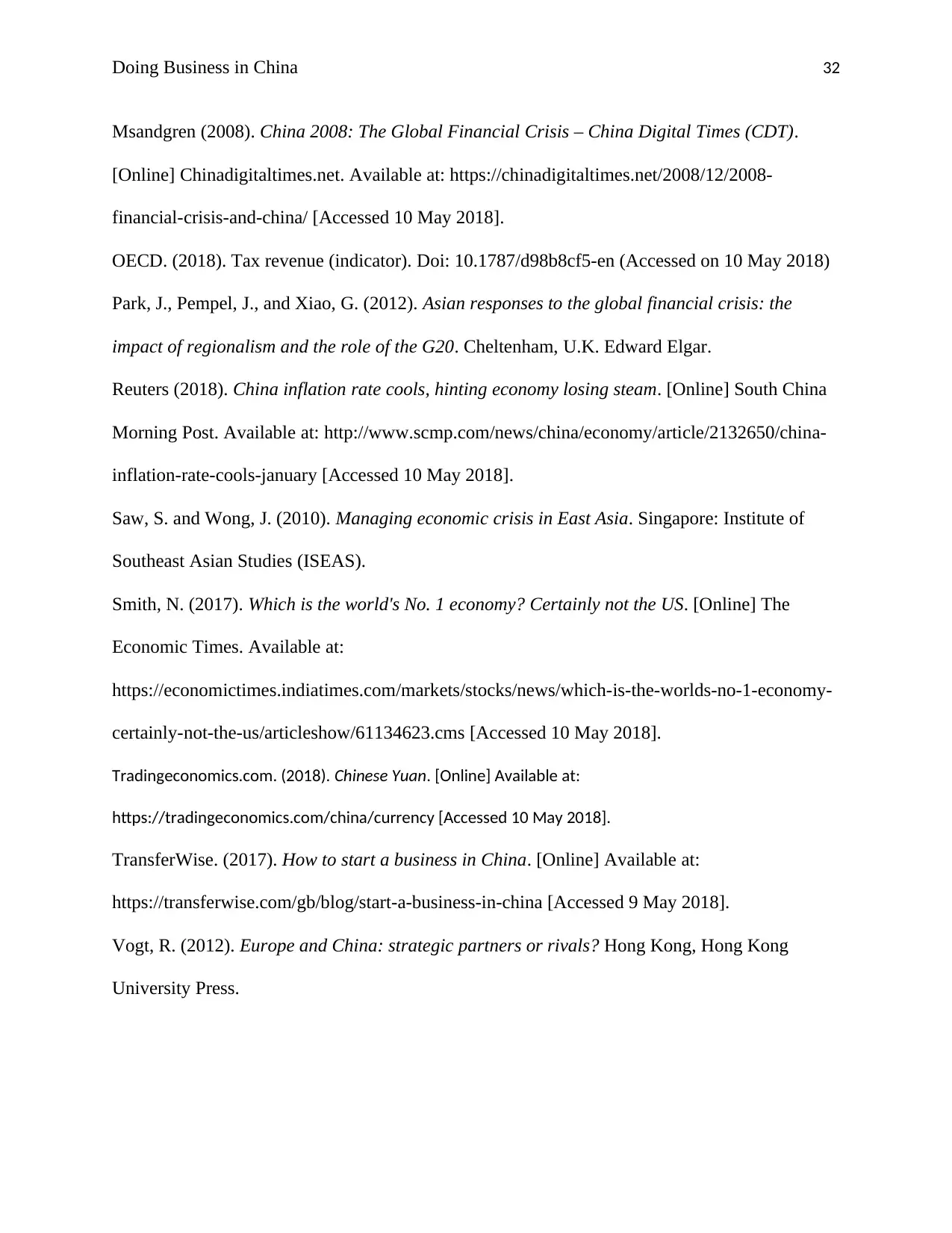
Doing Business in China 32
Msandgren (2008). China 2008: The Global Financial Crisis – China Digital Times (CDT).
[Online] Chinadigitaltimes.net. Available at: https://chinadigitaltimes.net/2008/12/2008-
financial-crisis-and-china/ [Accessed 10 May 2018].
OECD. (2018). Tax revenue (indicator). Doi: 10.1787/d98b8cf5-en (Accessed on 10 May 2018)
Park, J., Pempel, J., and Xiao, G. (2012). Asian responses to the global financial crisis: the
impact of regionalism and the role of the G20. Cheltenham, U.K. Edward Elgar.
Reuters (2018). China inflation rate cools, hinting economy losing steam. [Online] South China
Morning Post. Available at: http://www.scmp.com/news/china/economy/article/2132650/china-
inflation-rate-cools-january [Accessed 10 May 2018].
Saw, S. and Wong, J. (2010). Managing economic crisis in East Asia. Singapore: Institute of
Southeast Asian Studies (ISEAS).
Smith, N. (2017). Which is the world's No. 1 economy? Certainly not the US. [Online] The
Economic Times. Available at:
https://economictimes.indiatimes.com/markets/stocks/news/which-is-the-worlds-no-1-economy-
certainly-not-the-us/articleshow/61134623.cms [Accessed 10 May 2018].
Tradingeconomics.com. (2018). Chinese Yuan. [Online] Available at:
https://tradingeconomics.com/china/currency [Accessed 10 May 2018].
TransferWise. (2017). How to start a business in China. [Online] Available at:
https://transferwise.com/gb/blog/start-a-business-in-china [Accessed 9 May 2018].
Vogt, R. (2012). Europe and China: strategic partners or rivals? Hong Kong, Hong Kong
University Press.
Msandgren (2008). China 2008: The Global Financial Crisis – China Digital Times (CDT).
[Online] Chinadigitaltimes.net. Available at: https://chinadigitaltimes.net/2008/12/2008-
financial-crisis-and-china/ [Accessed 10 May 2018].
OECD. (2018). Tax revenue (indicator). Doi: 10.1787/d98b8cf5-en (Accessed on 10 May 2018)
Park, J., Pempel, J., and Xiao, G. (2012). Asian responses to the global financial crisis: the
impact of regionalism and the role of the G20. Cheltenham, U.K. Edward Elgar.
Reuters (2018). China inflation rate cools, hinting economy losing steam. [Online] South China
Morning Post. Available at: http://www.scmp.com/news/china/economy/article/2132650/china-
inflation-rate-cools-january [Accessed 10 May 2018].
Saw, S. and Wong, J. (2010). Managing economic crisis in East Asia. Singapore: Institute of
Southeast Asian Studies (ISEAS).
Smith, N. (2017). Which is the world's No. 1 economy? Certainly not the US. [Online] The
Economic Times. Available at:
https://economictimes.indiatimes.com/markets/stocks/news/which-is-the-worlds-no-1-economy-
certainly-not-the-us/articleshow/61134623.cms [Accessed 10 May 2018].
Tradingeconomics.com. (2018). Chinese Yuan. [Online] Available at:
https://tradingeconomics.com/china/currency [Accessed 10 May 2018].
TransferWise. (2017). How to start a business in China. [Online] Available at:
https://transferwise.com/gb/blog/start-a-business-in-china [Accessed 9 May 2018].
Vogt, R. (2012). Europe and China: strategic partners or rivals? Hong Kong, Hong Kong
University Press.
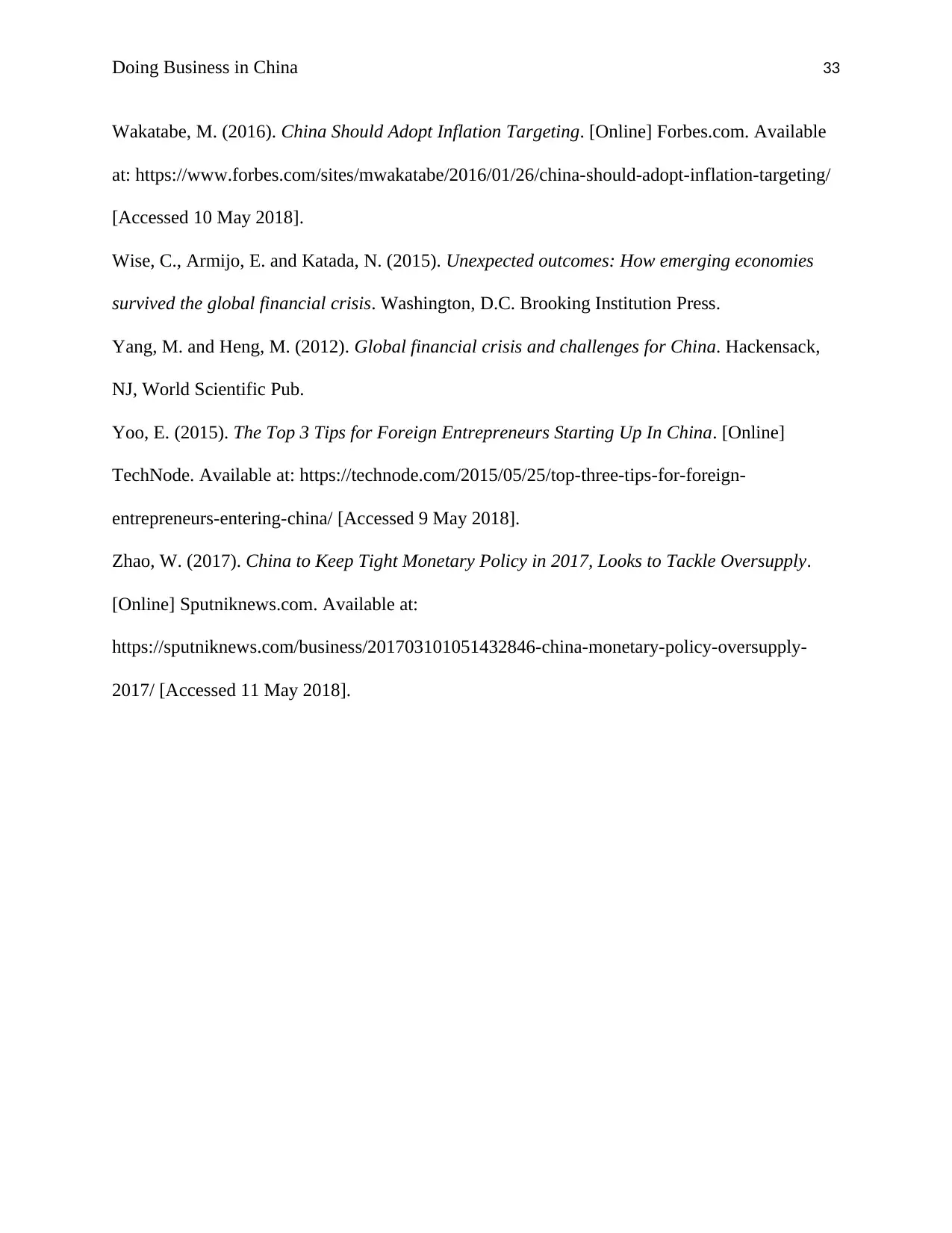
Doing Business in China 33
Wakatabe, M. (2016). China Should Adopt Inflation Targeting. [Online] Forbes.com. Available
at: https://www.forbes.com/sites/mwakatabe/2016/01/26/china-should-adopt-inflation-targeting/
[Accessed 10 May 2018].
Wise, C., Armijo, E. and Katada, N. (2015). Unexpected outcomes: How emerging economies
survived the global financial crisis. Washington, D.C. Brooking Institution Press.
Yang, M. and Heng, M. (2012). Global financial crisis and challenges for China. Hackensack,
NJ, World Scientific Pub.
Yoo, E. (2015). The Top 3 Tips for Foreign Entrepreneurs Starting Up In China. [Online]
TechNode. Available at: https://technode.com/2015/05/25/top-three-tips-for-foreign-
entrepreneurs-entering-china/ [Accessed 9 May 2018].
Zhao, W. (2017). China to Keep Tight Monetary Policy in 2017, Looks to Tackle Oversupply.
[Online] Sputniknews.com. Available at:
https://sputniknews.com/business/201703101051432846-china-monetary-policy-oversupply-
2017/ [Accessed 11 May 2018].
Wakatabe, M. (2016). China Should Adopt Inflation Targeting. [Online] Forbes.com. Available
at: https://www.forbes.com/sites/mwakatabe/2016/01/26/china-should-adopt-inflation-targeting/
[Accessed 10 May 2018].
Wise, C., Armijo, E. and Katada, N. (2015). Unexpected outcomes: How emerging economies
survived the global financial crisis. Washington, D.C. Brooking Institution Press.
Yang, M. and Heng, M. (2012). Global financial crisis and challenges for China. Hackensack,
NJ, World Scientific Pub.
Yoo, E. (2015). The Top 3 Tips for Foreign Entrepreneurs Starting Up In China. [Online]
TechNode. Available at: https://technode.com/2015/05/25/top-three-tips-for-foreign-
entrepreneurs-entering-china/ [Accessed 9 May 2018].
Zhao, W. (2017). China to Keep Tight Monetary Policy in 2017, Looks to Tackle Oversupply.
[Online] Sputniknews.com. Available at:
https://sputniknews.com/business/201703101051432846-china-monetary-policy-oversupply-
2017/ [Accessed 11 May 2018].
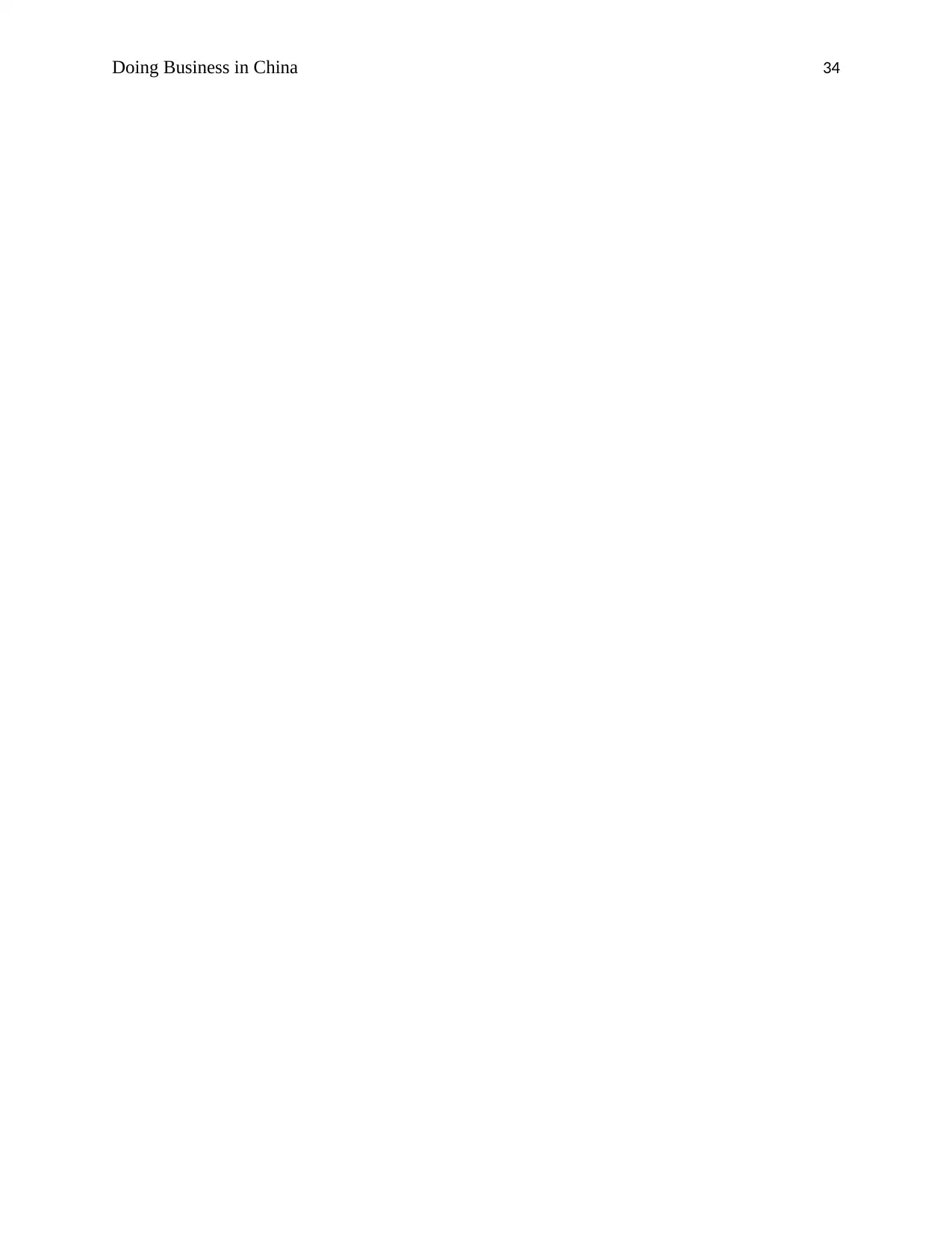
Doing Business in China 34
1 out of 34
Related Documents
Your All-in-One AI-Powered Toolkit for Academic Success.
+13062052269
info@desklib.com
Available 24*7 on WhatsApp / Email
![[object Object]](/_next/static/media/star-bottom.7253800d.svg)
Unlock your academic potential
© 2024 | Zucol Services PVT LTD | All rights reserved.





